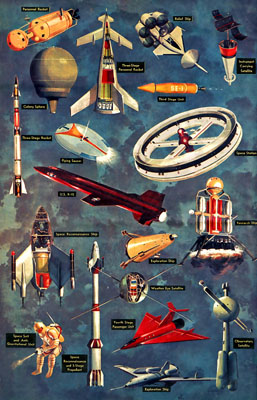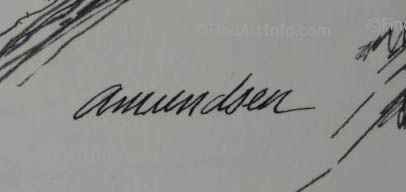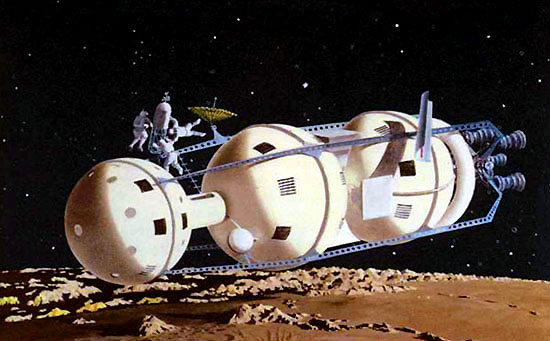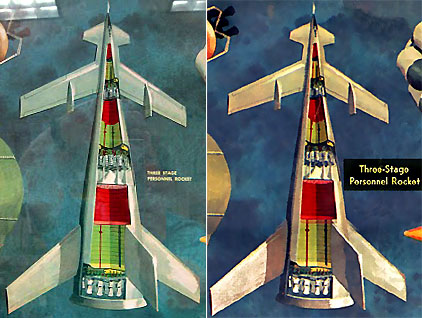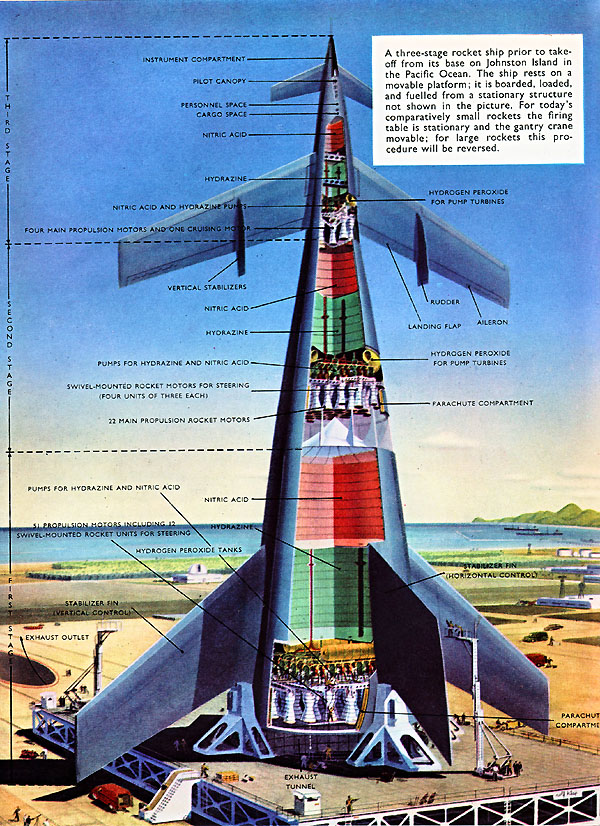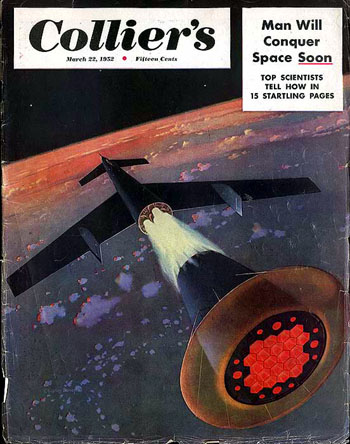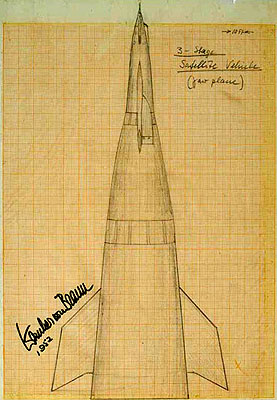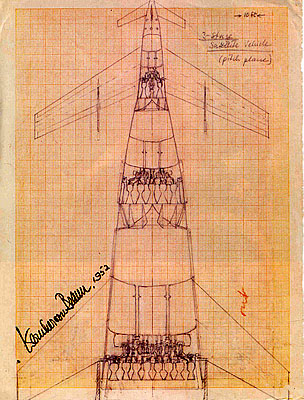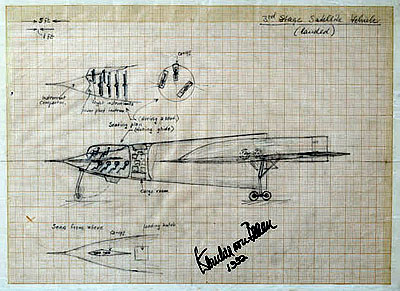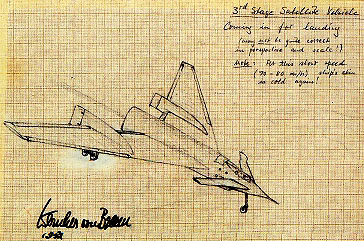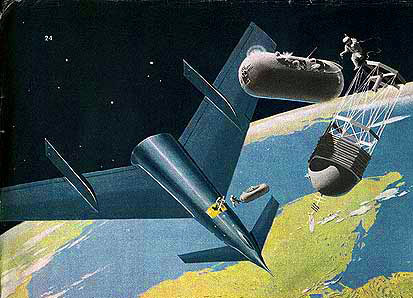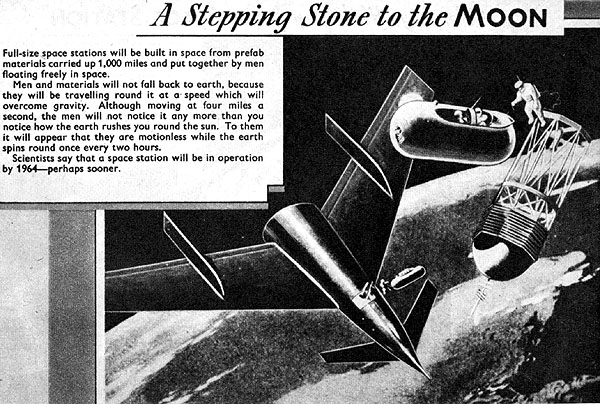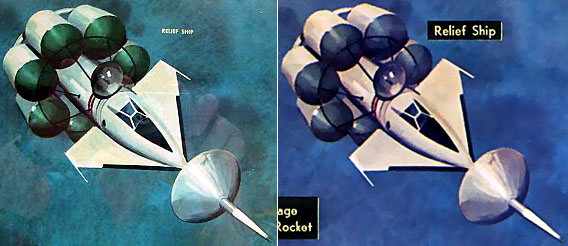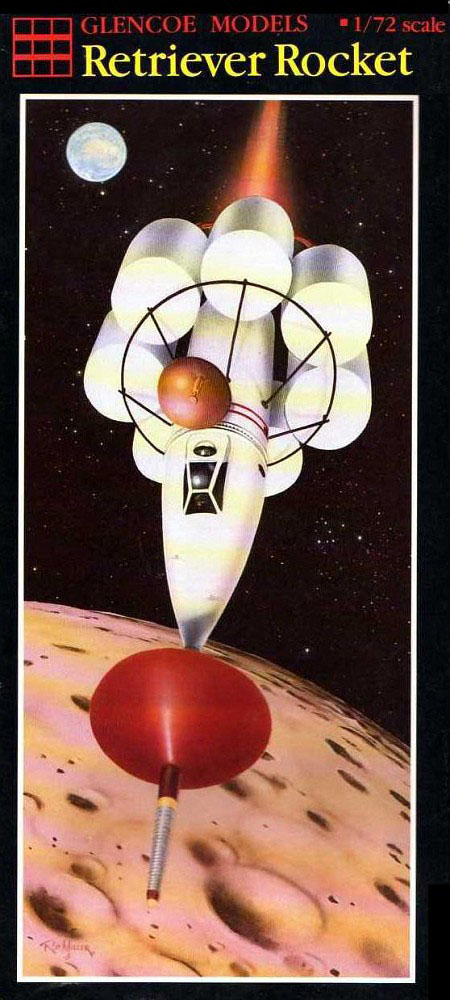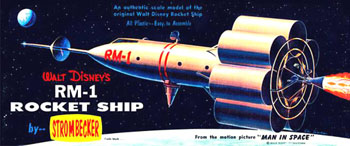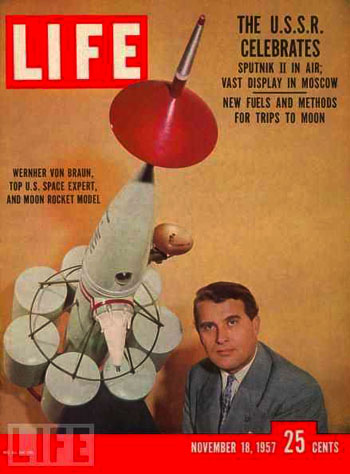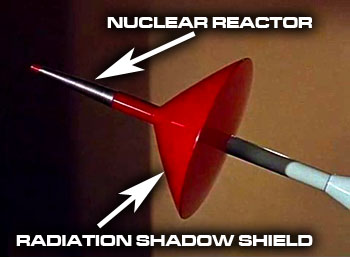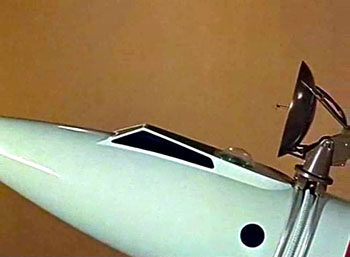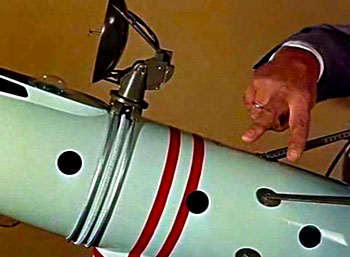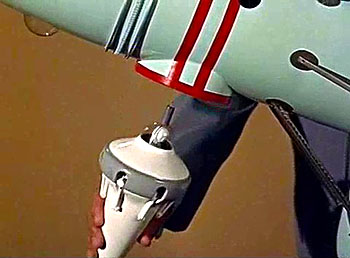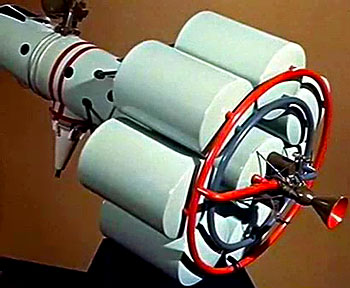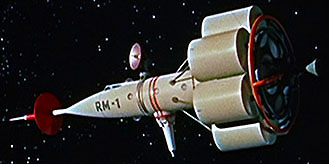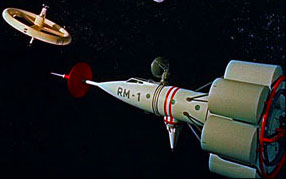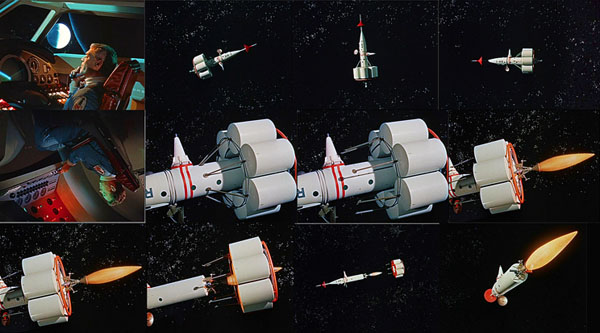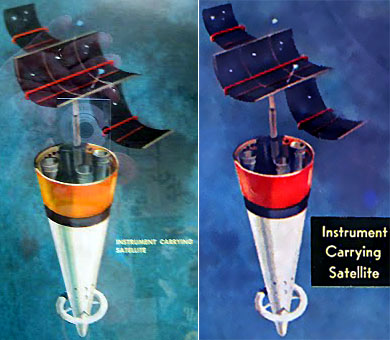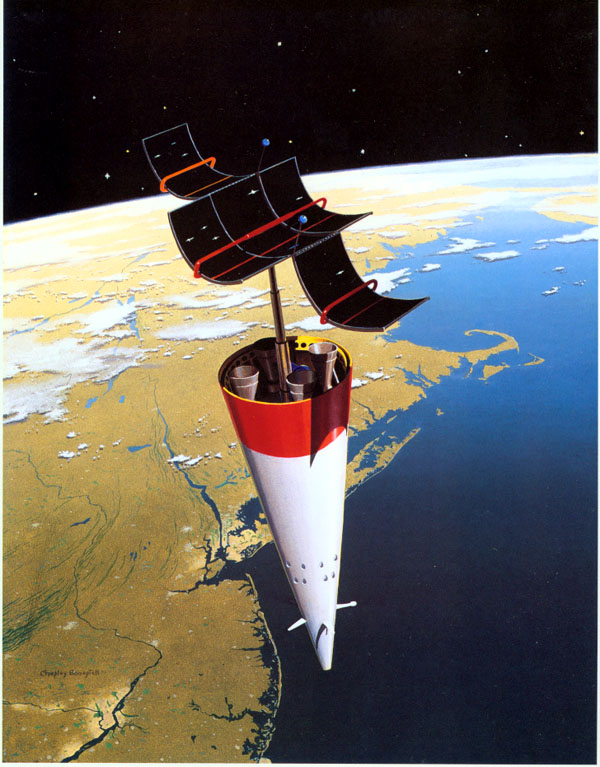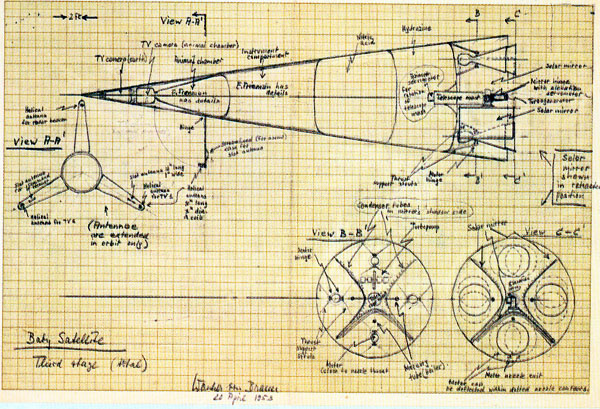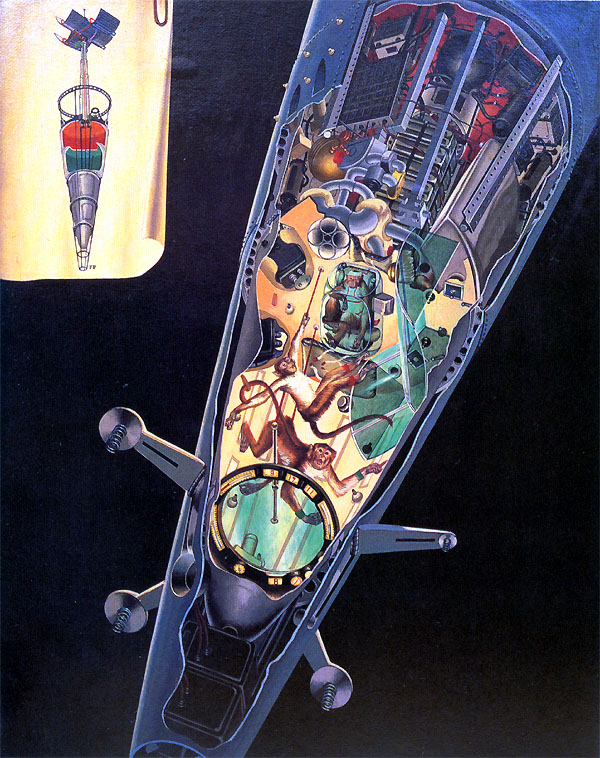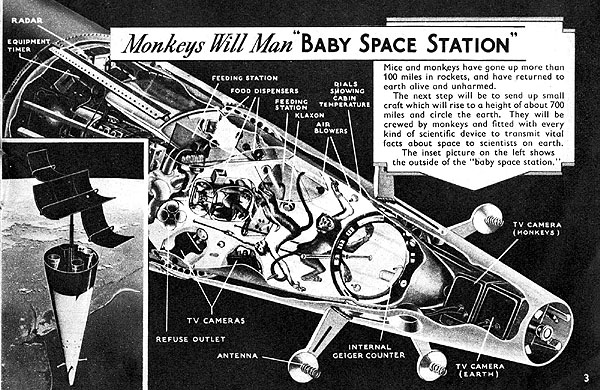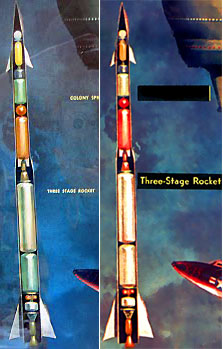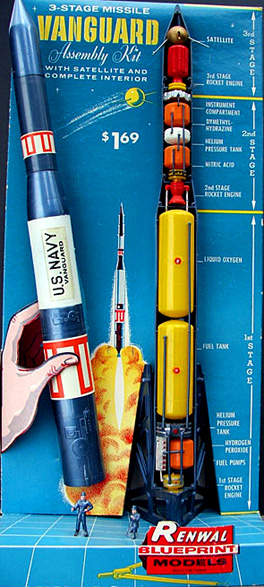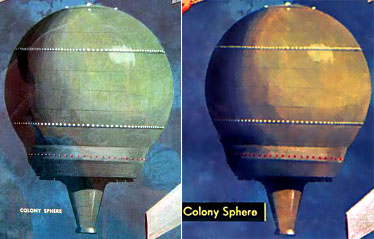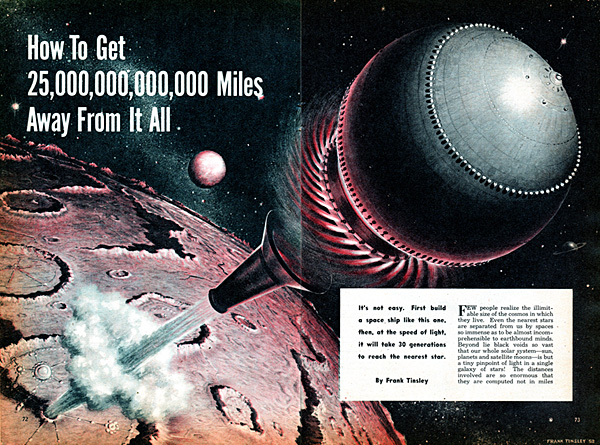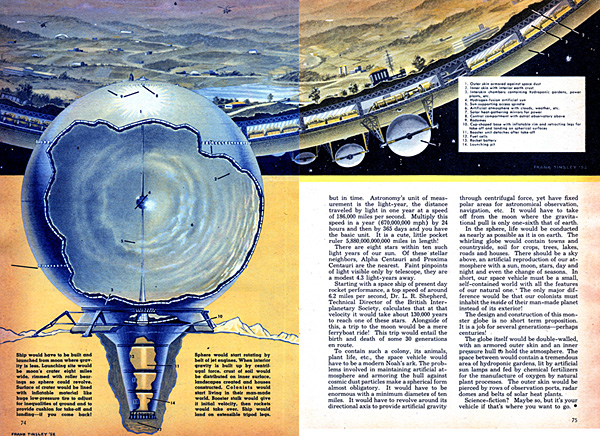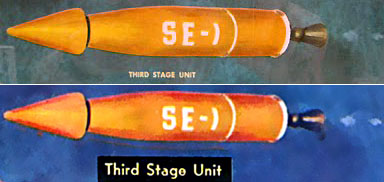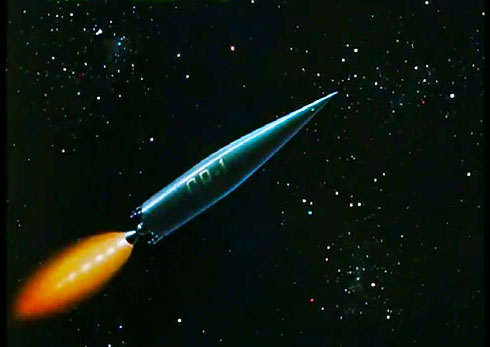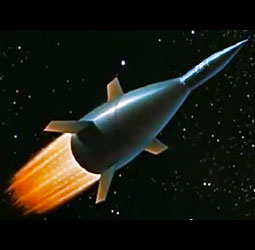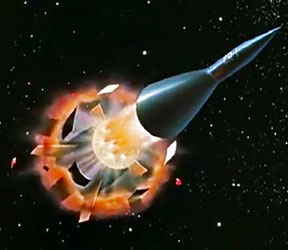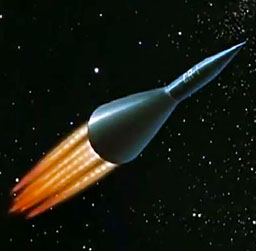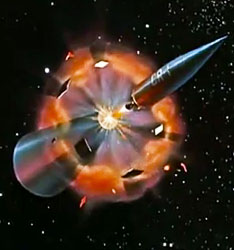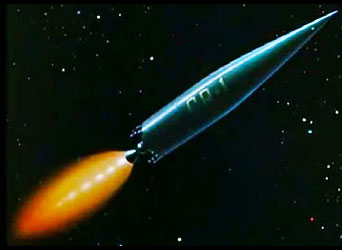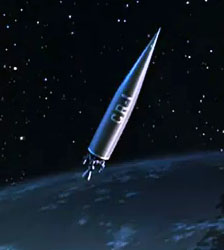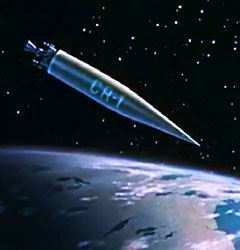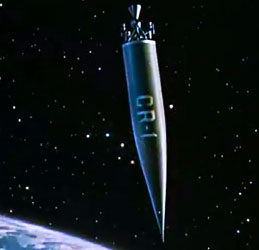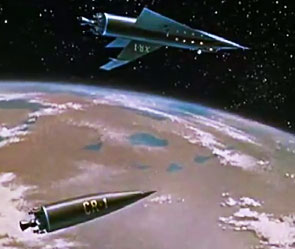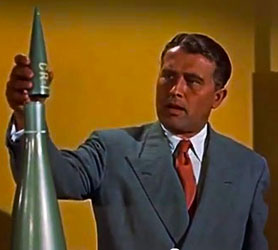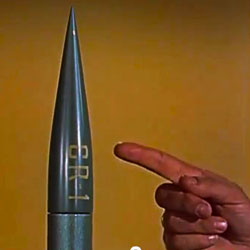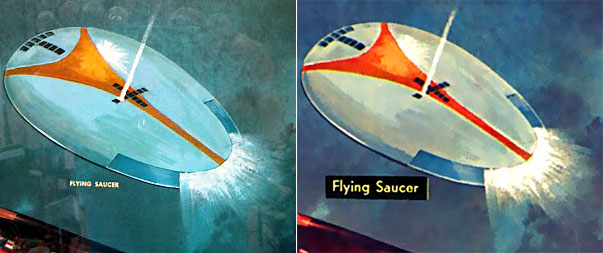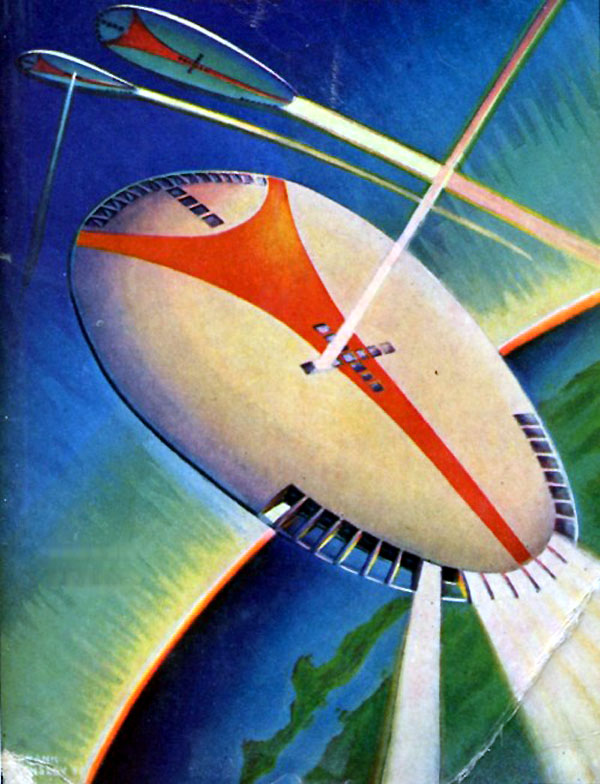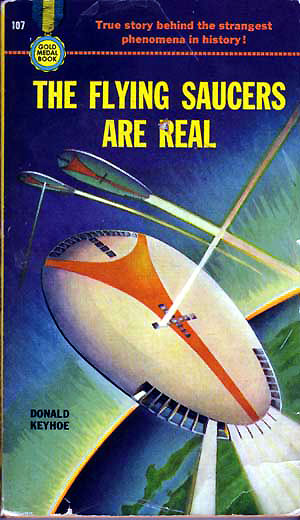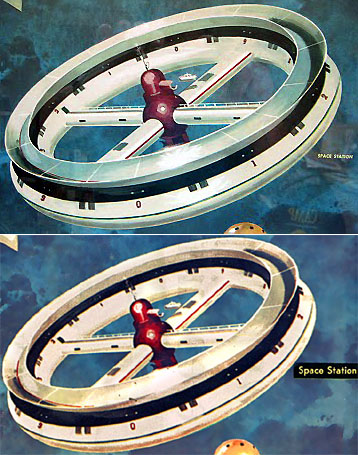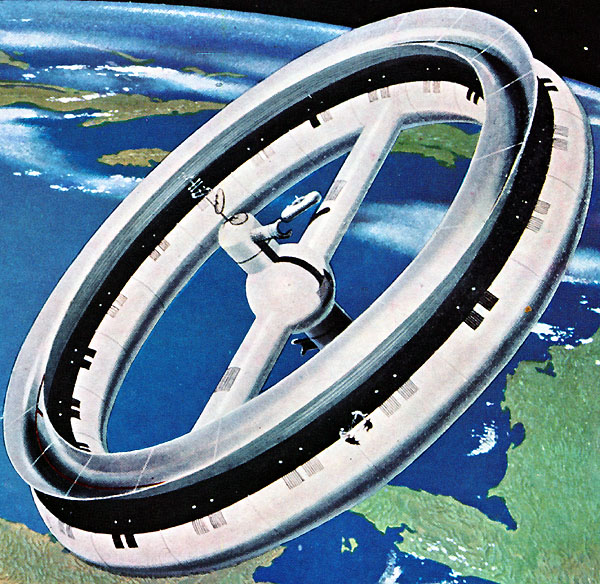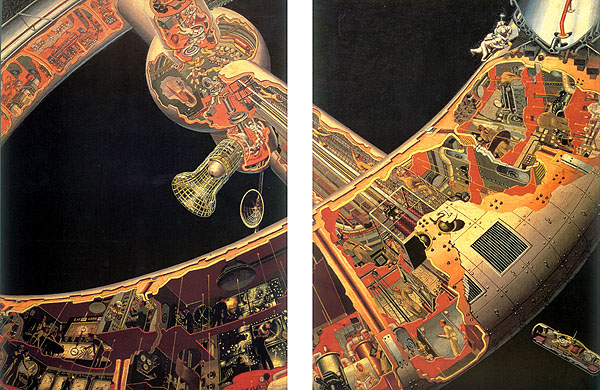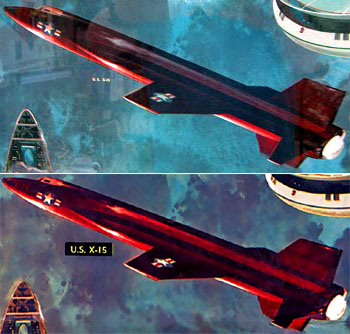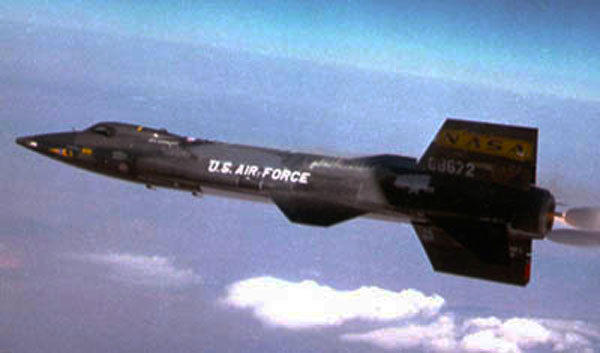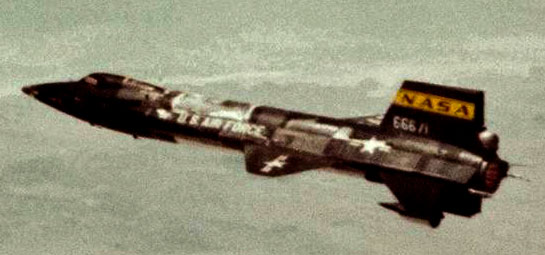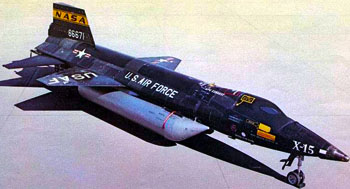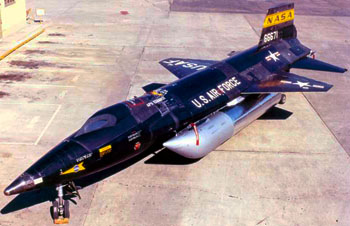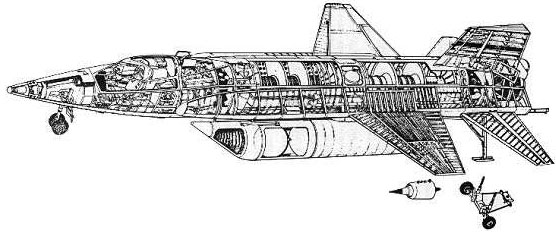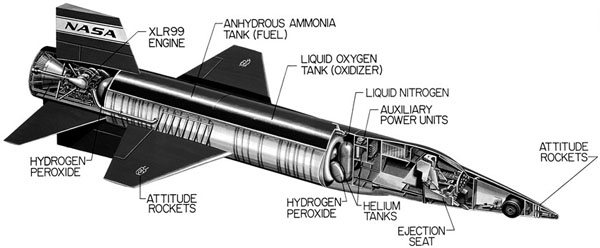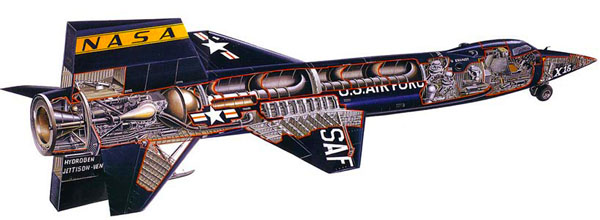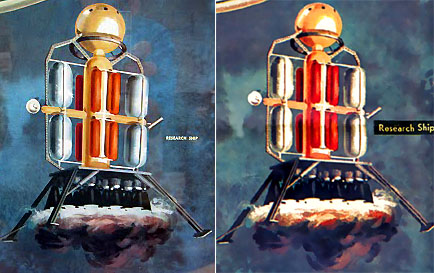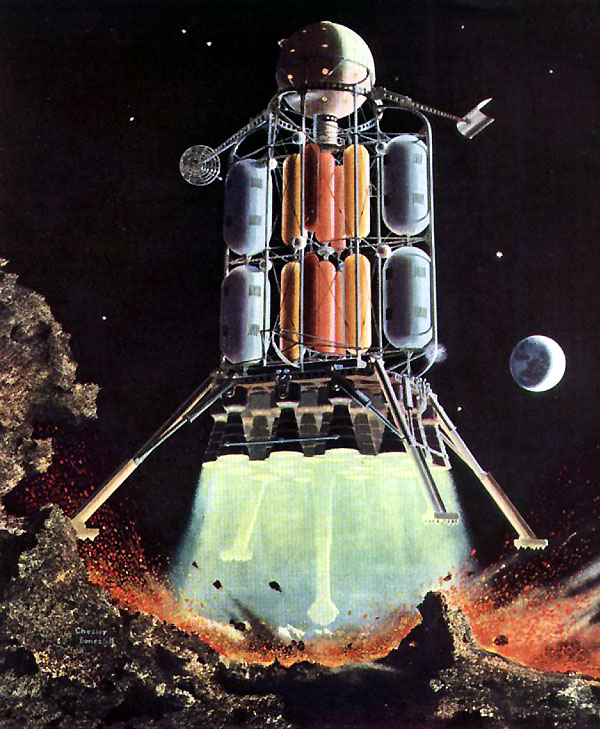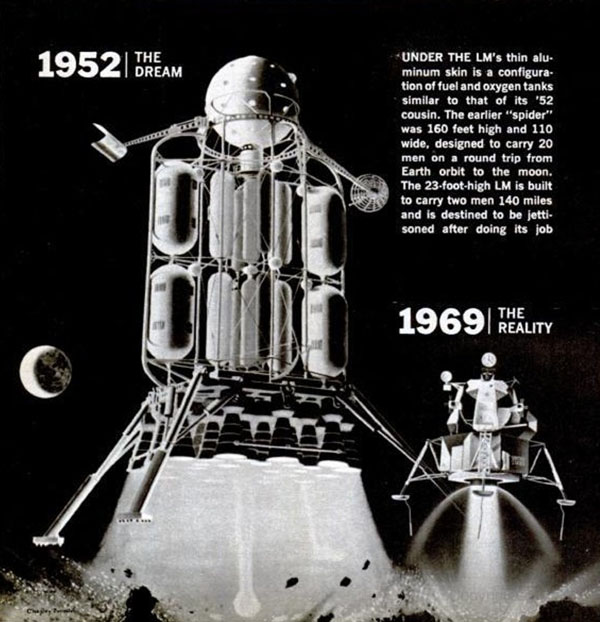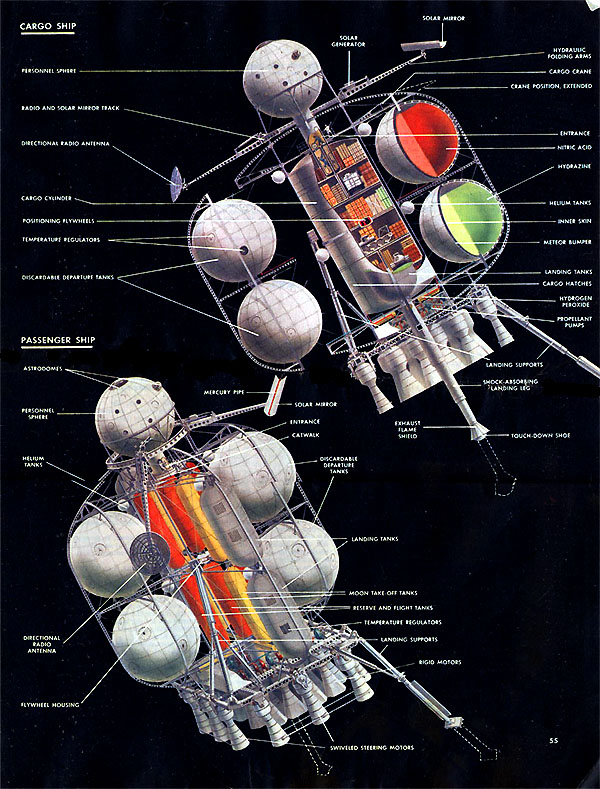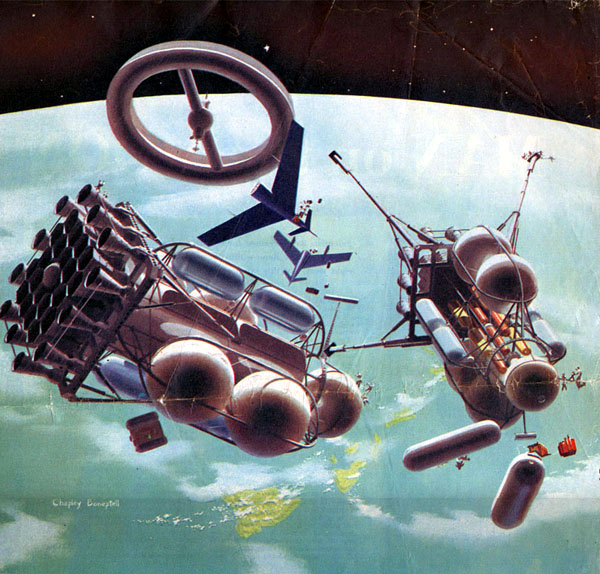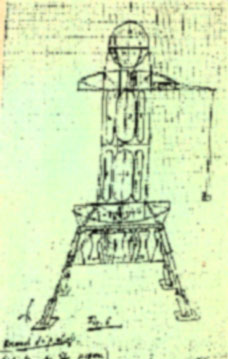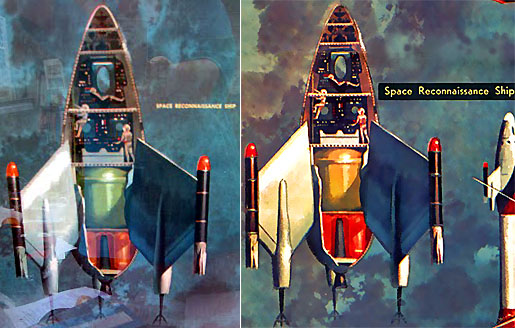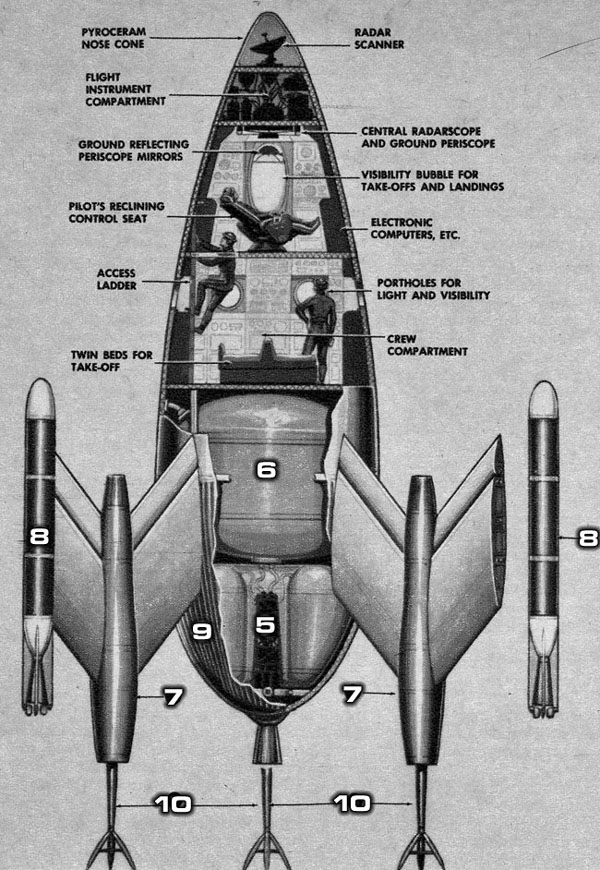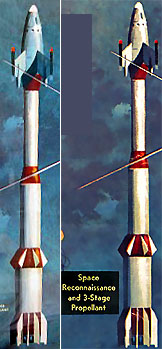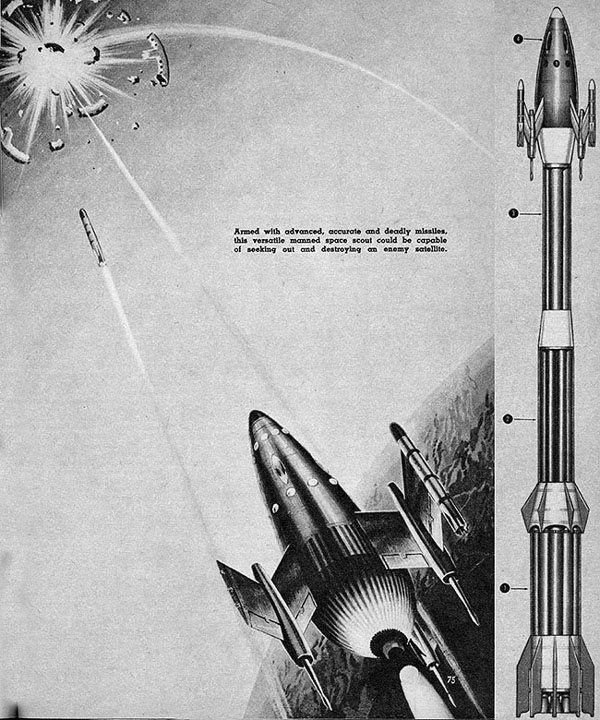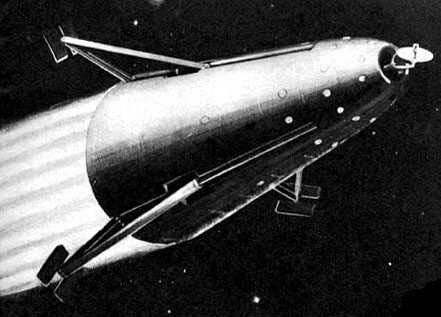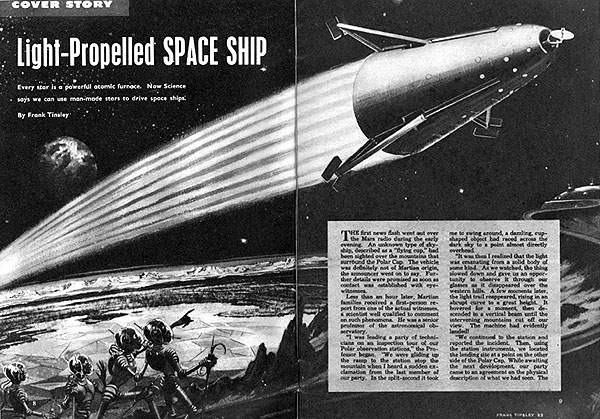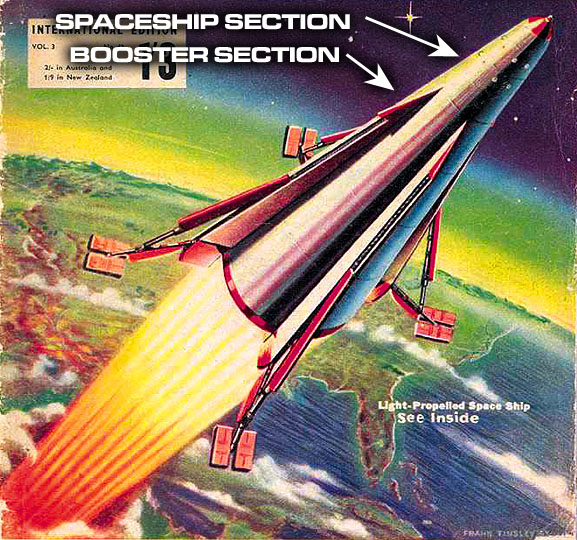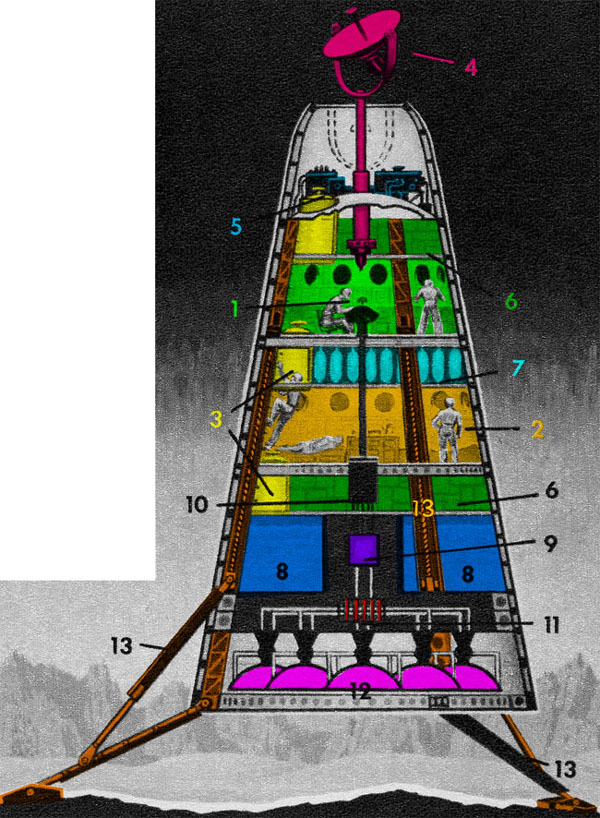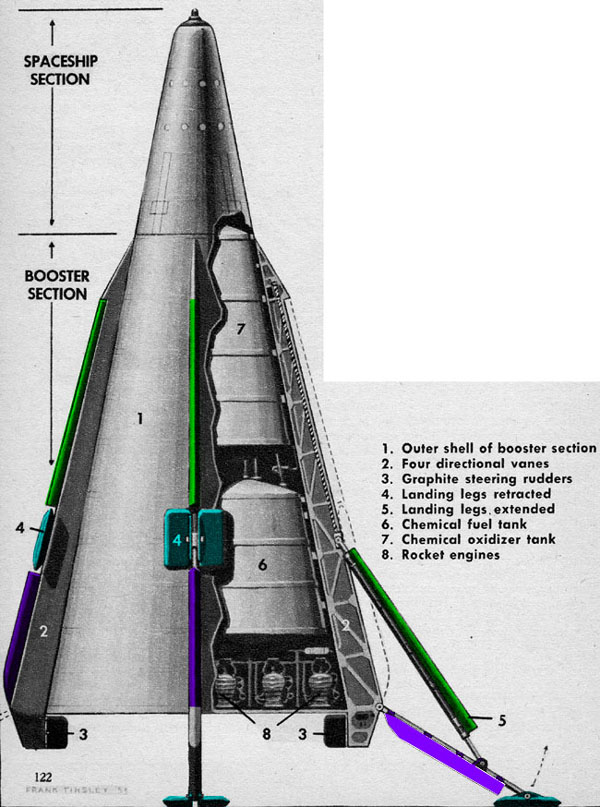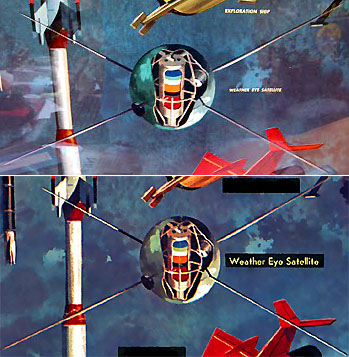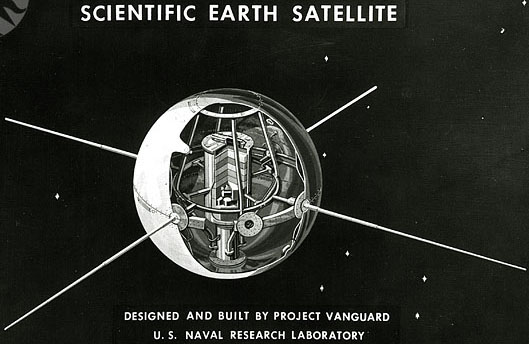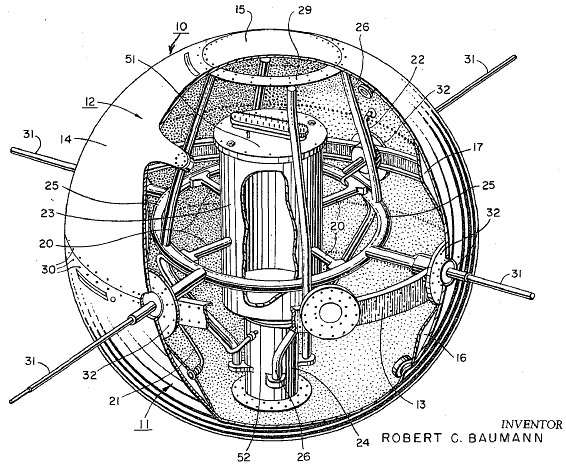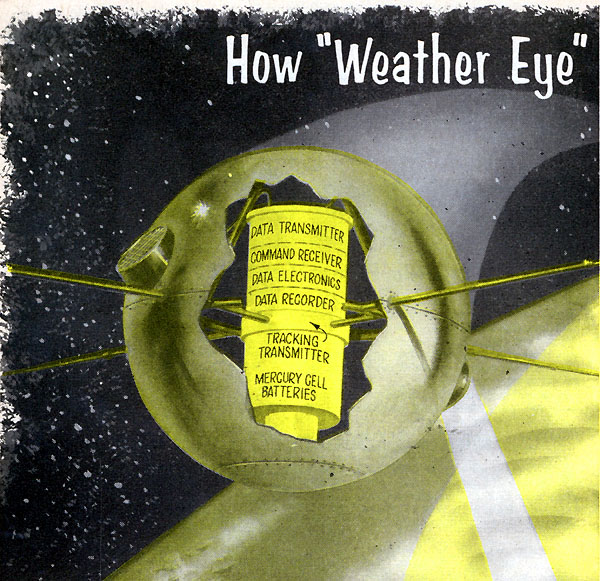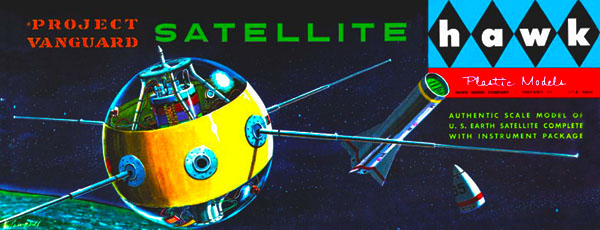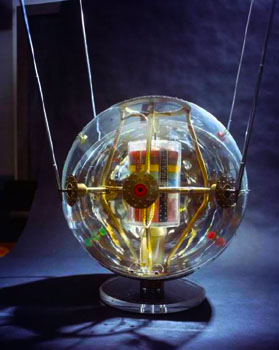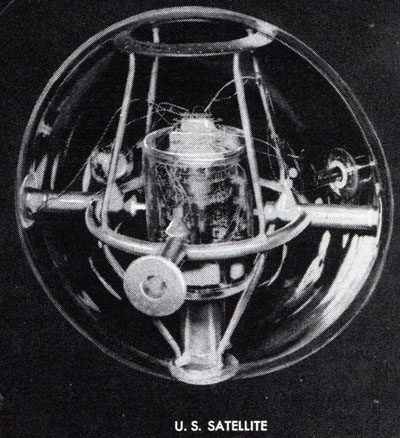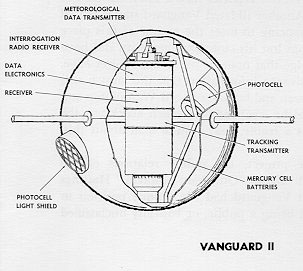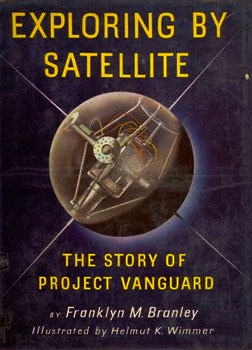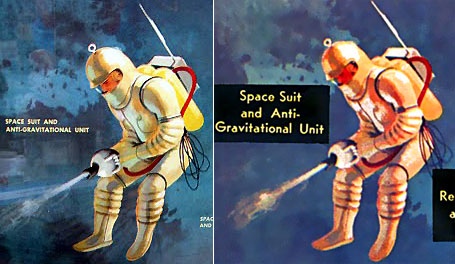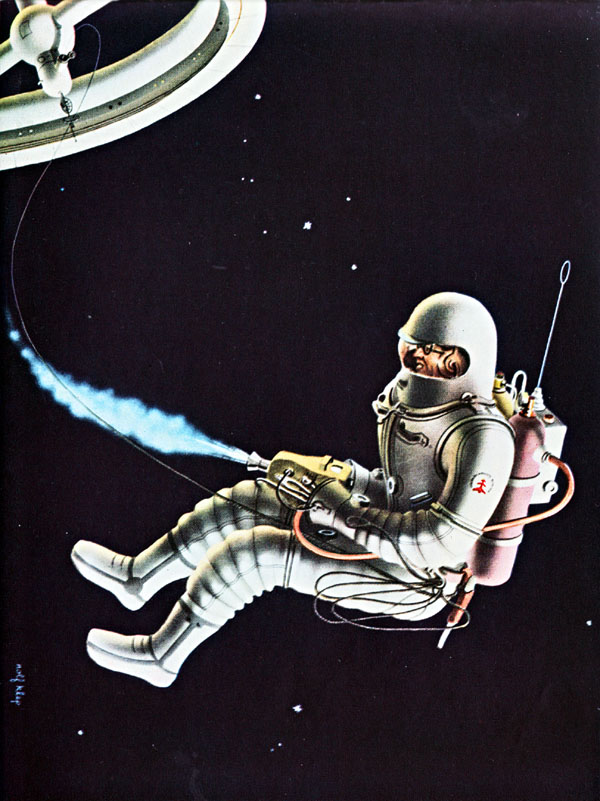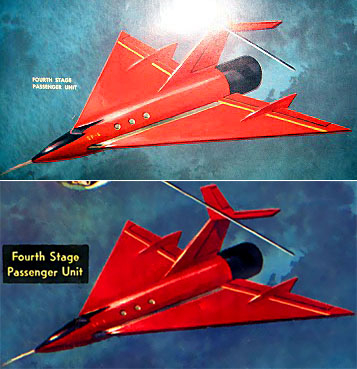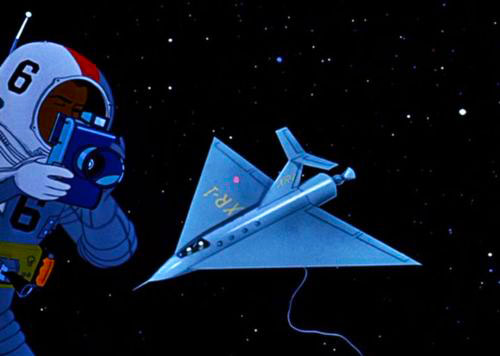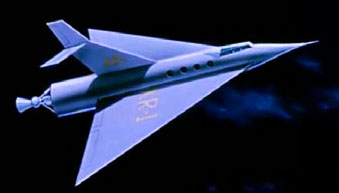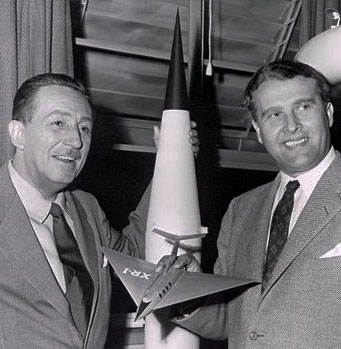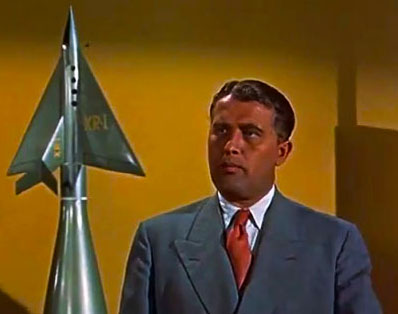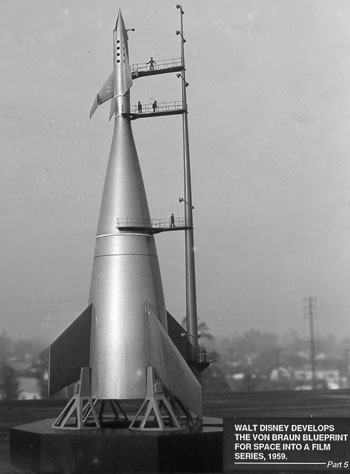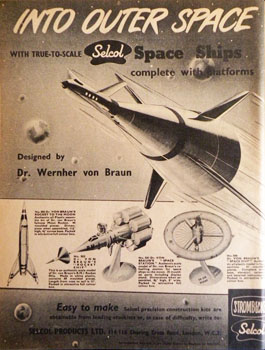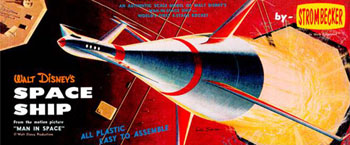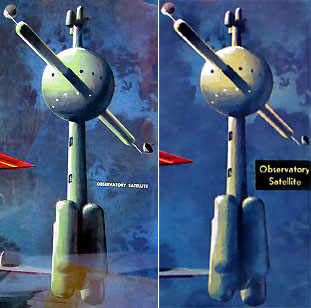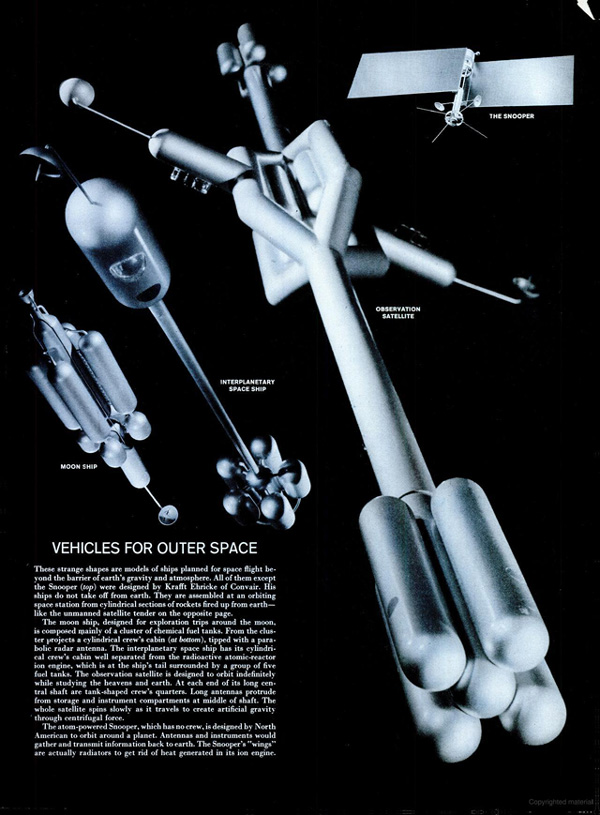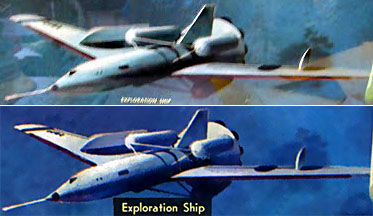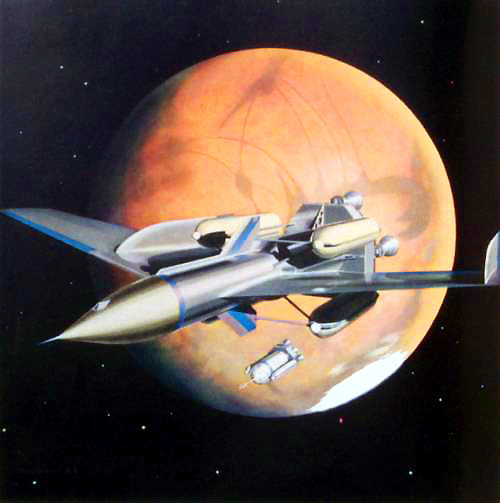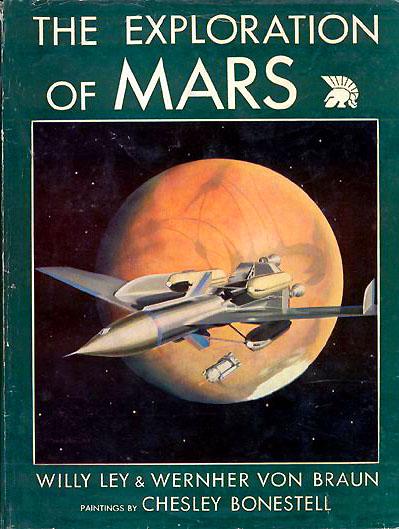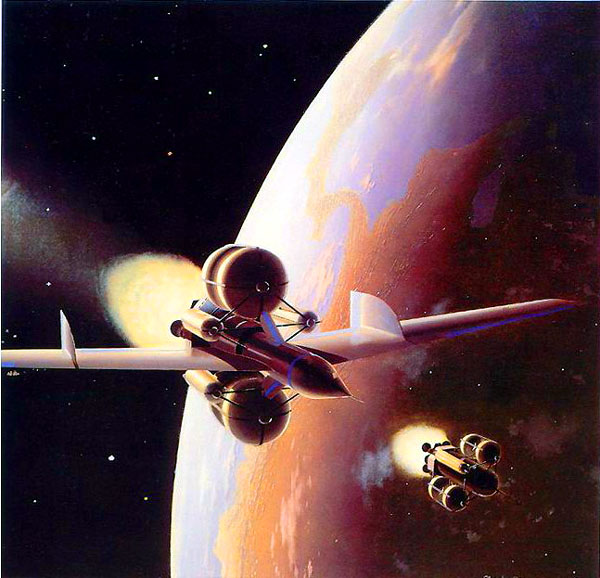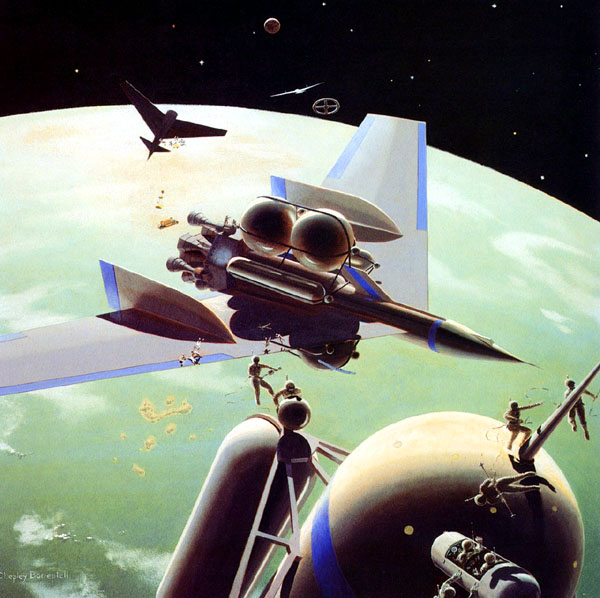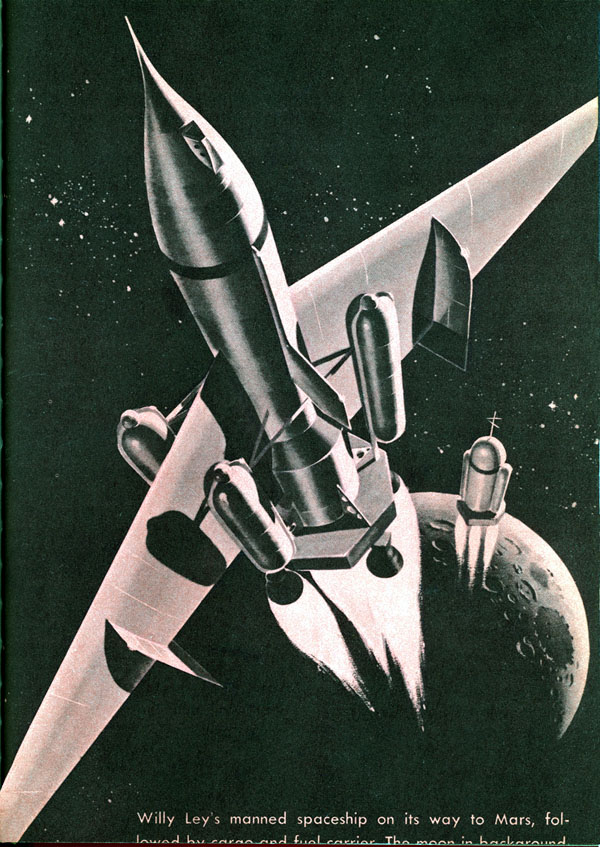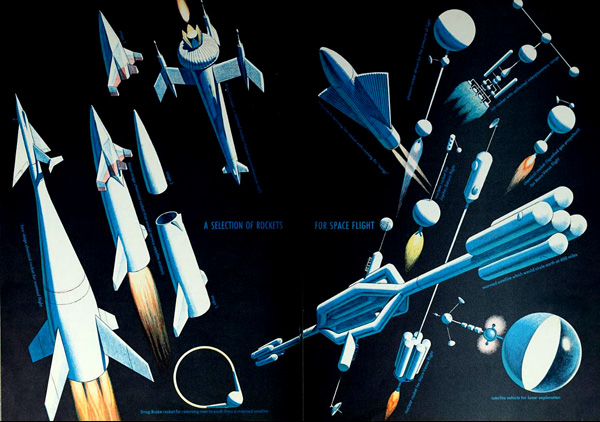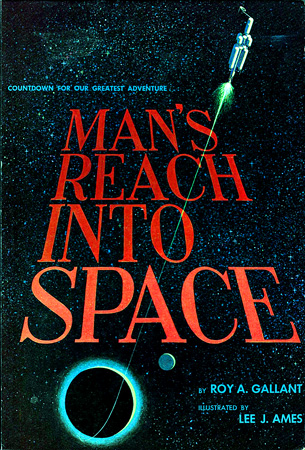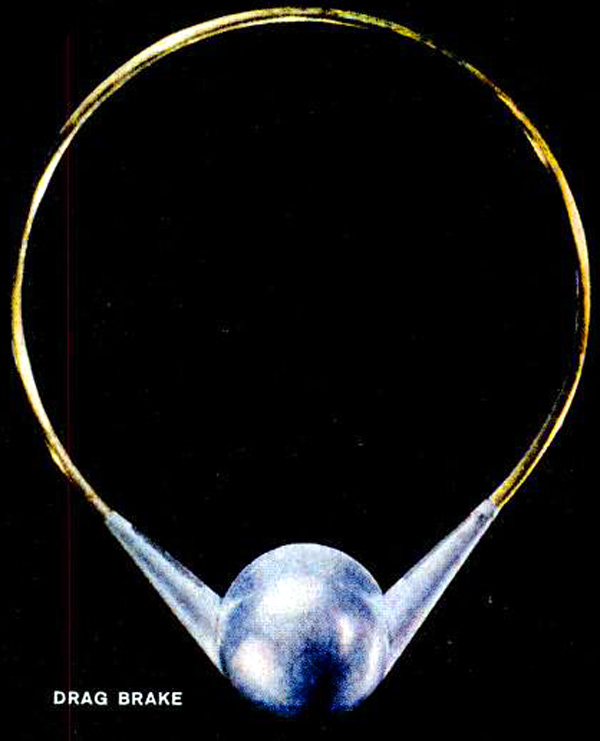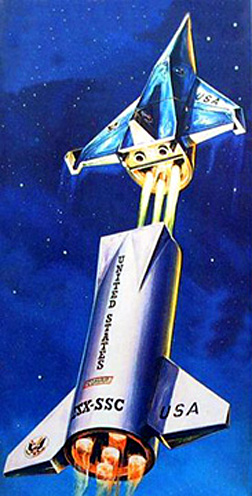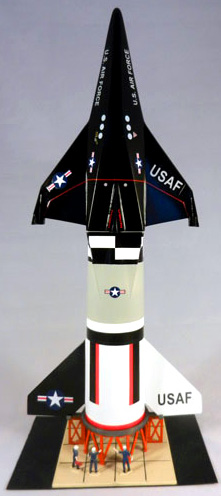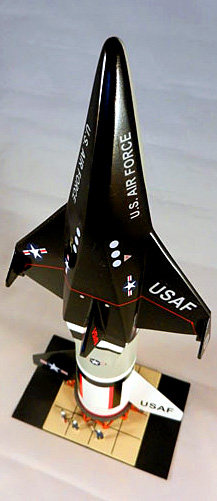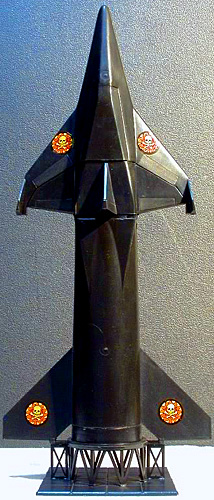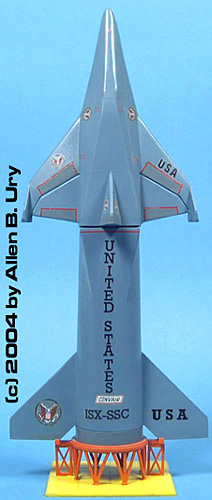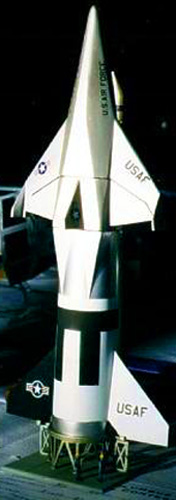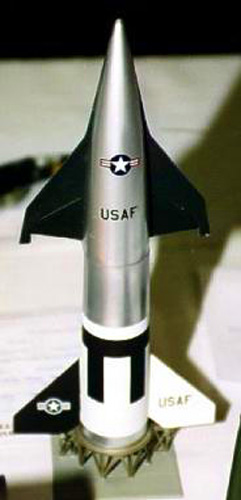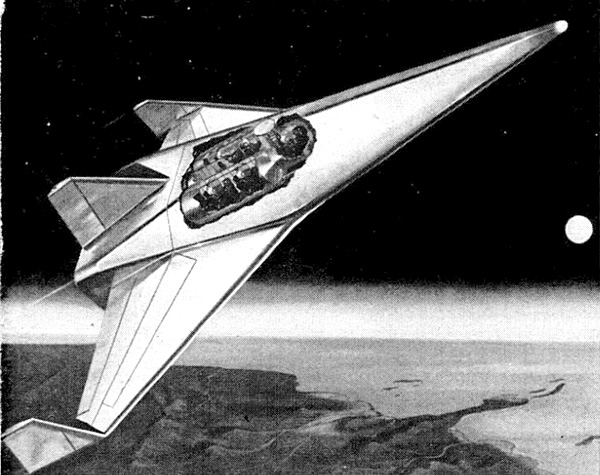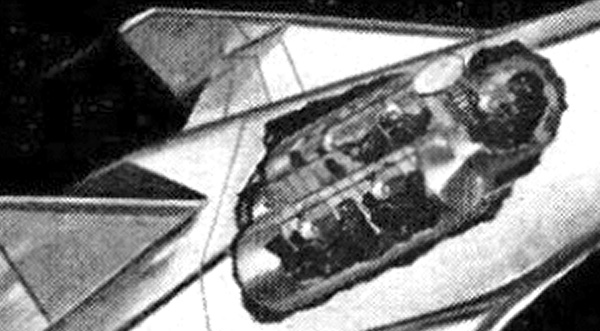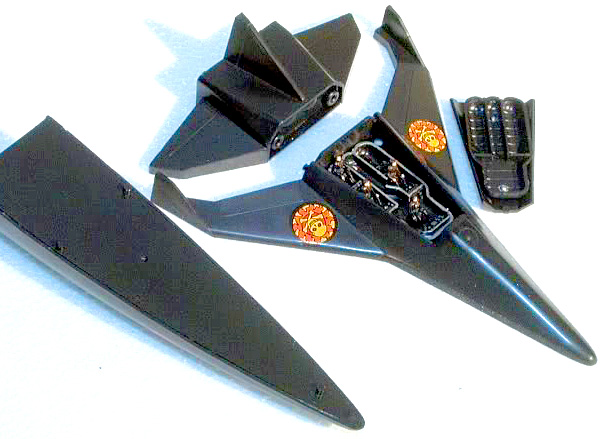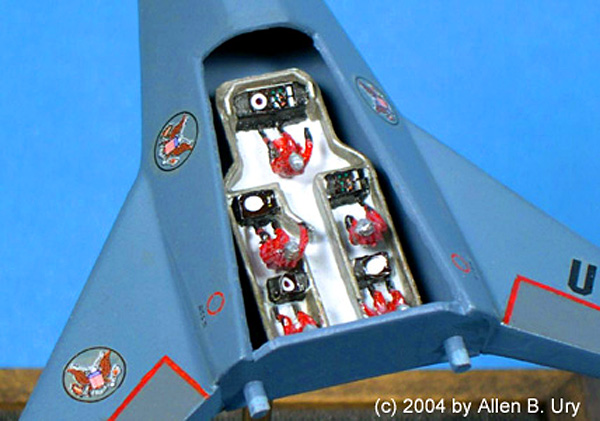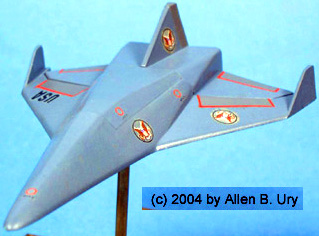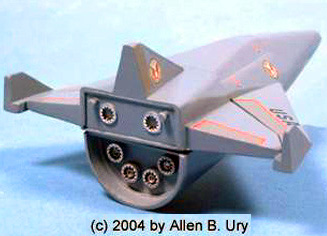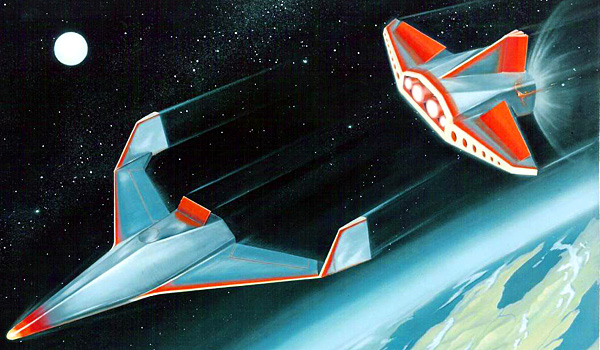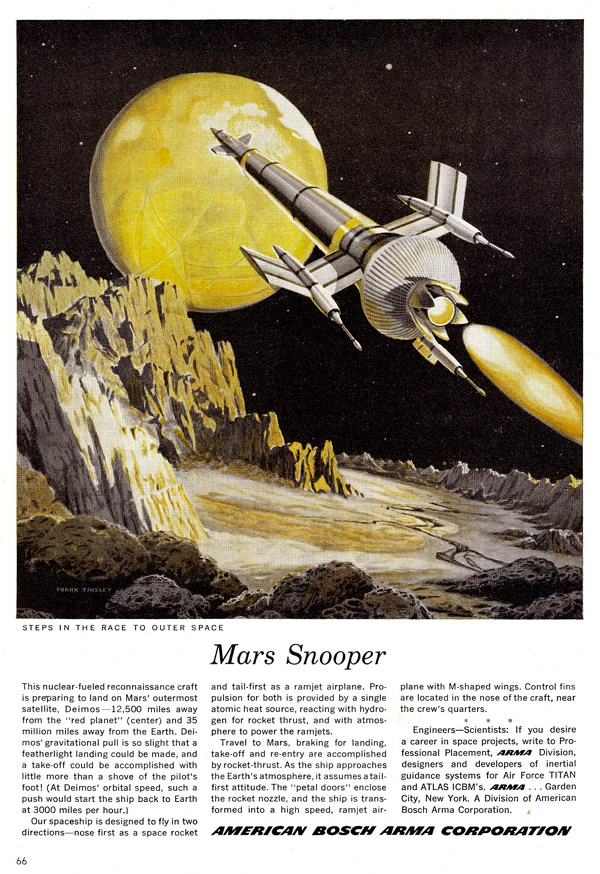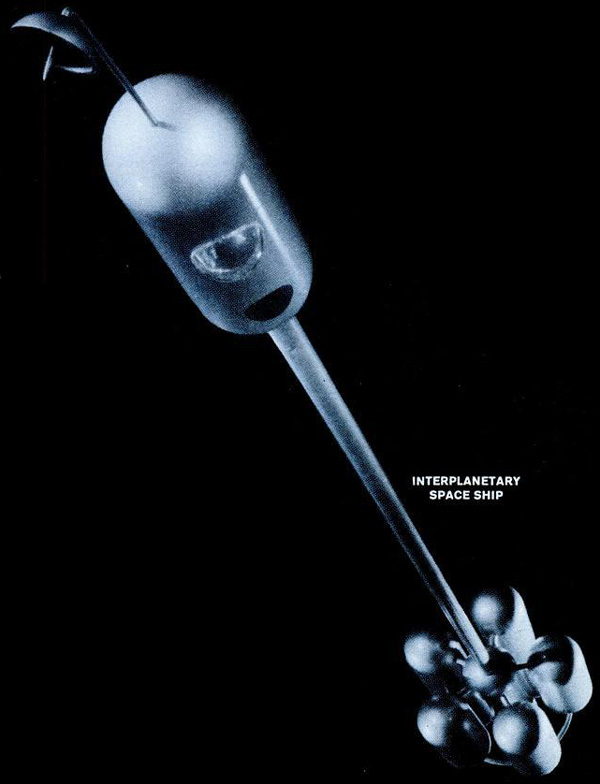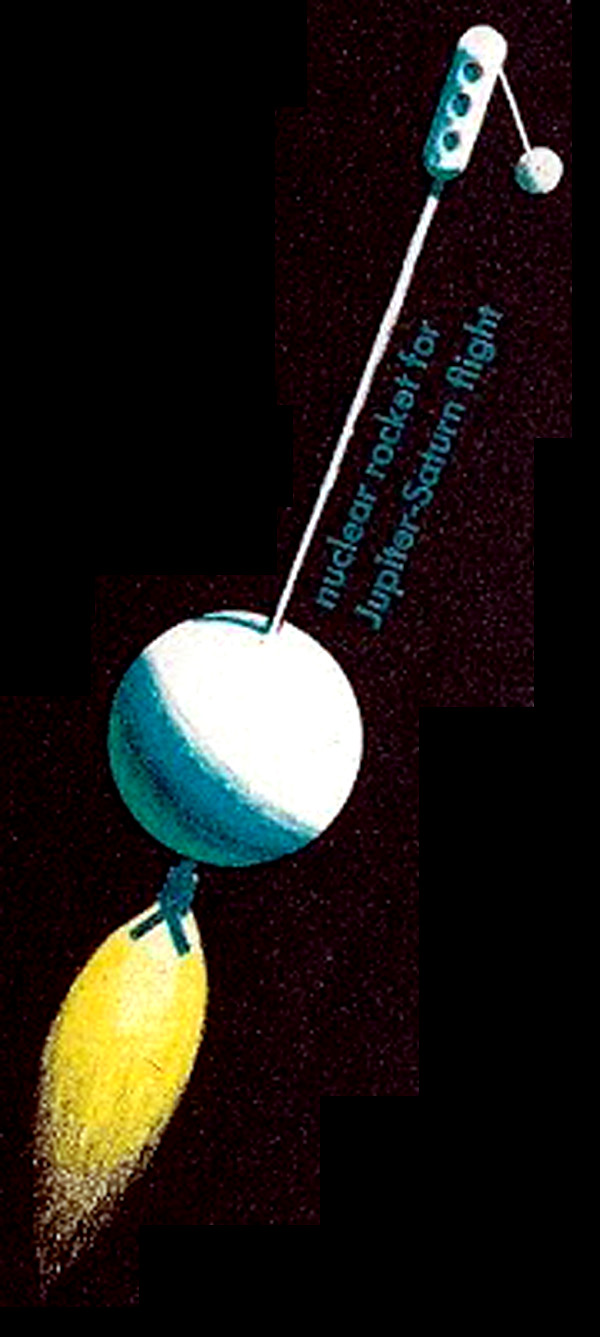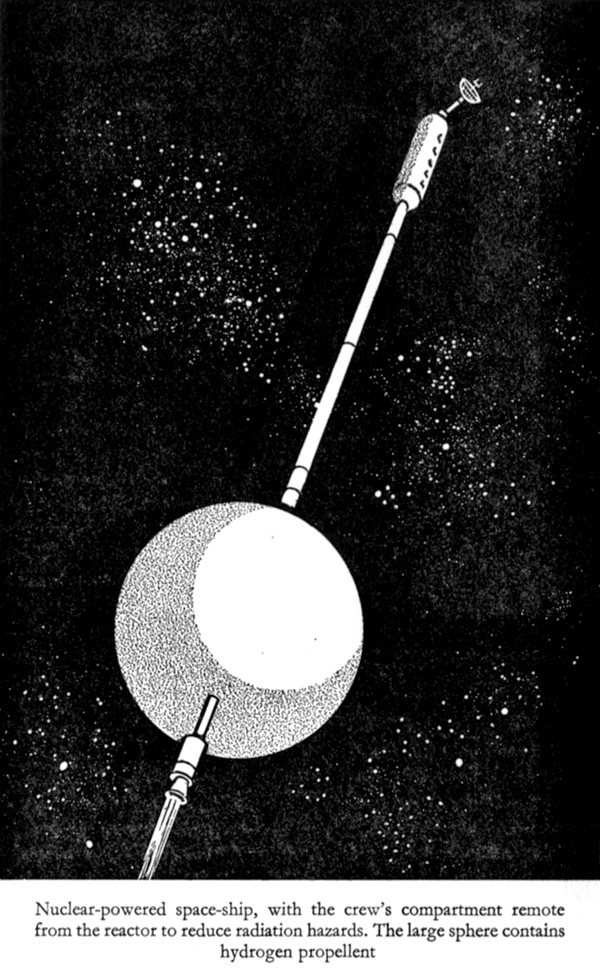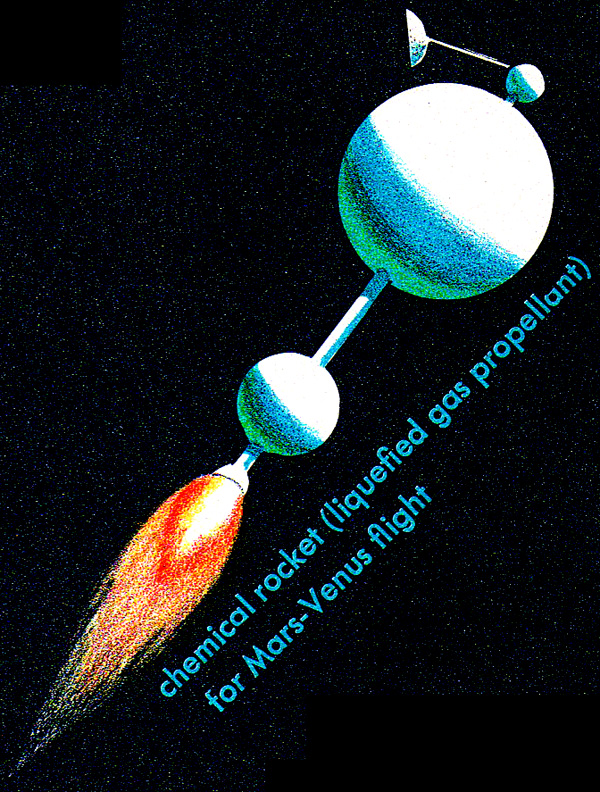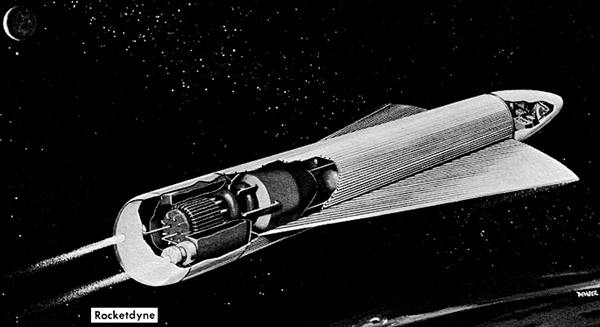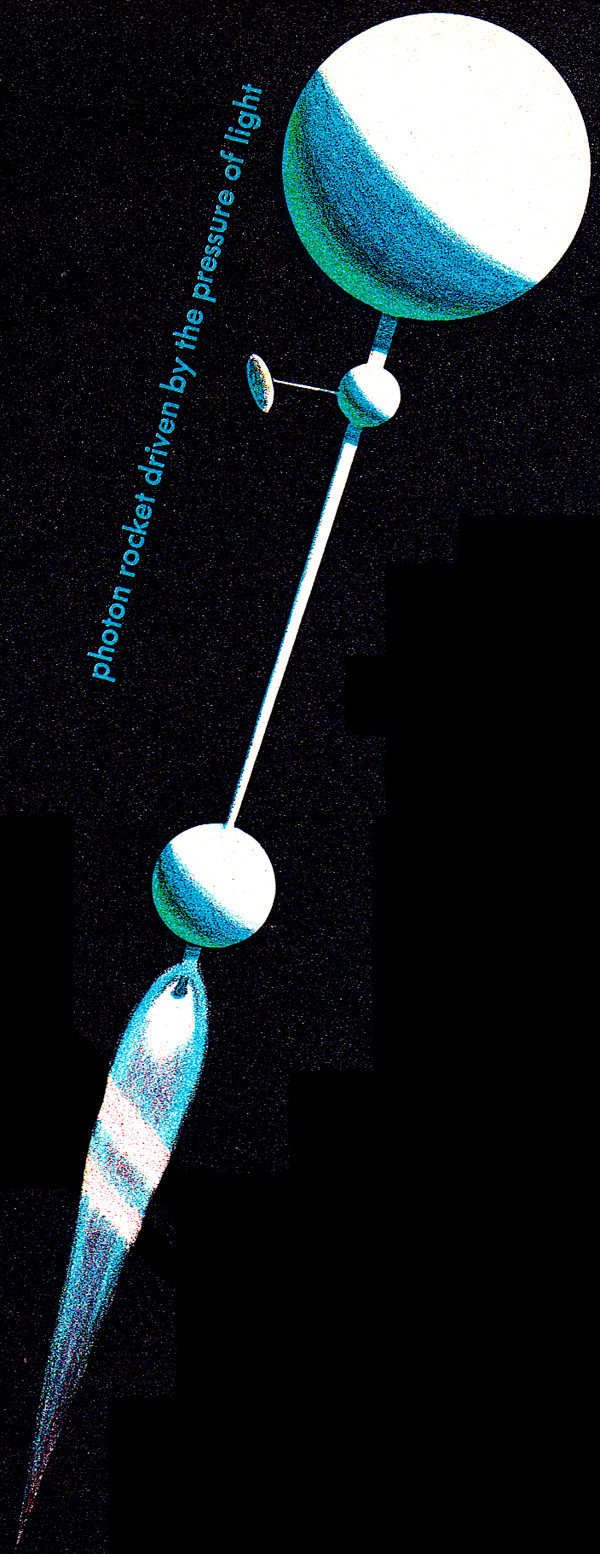SPACE AGE
When I was a little boy, my parents gave me a poster called "Space Age." I cherished it, studying all the many spaceships pictured on it. The poster came out in 1959. There are some notes on the poster here. Note that the labels next to the spaceships are white letters on a blue background. The only identifying information on it is: Copyright 1959 Educational Posters #117 "Space Age". The poster is signed, but nobody seems to be able to make out the scribble. For many people the poster sticks in their mind.
In the New York Mirror Magazine April 28 1963, the poster art was re-used in an article entitled "U.S. Space Hardware —Today and Tomorrow" by Fred Dickenson. There is a lo-res version of the article artwork here. You will note that in this version the labels next to the spaceships are white letters in a black box.
No, I do not know where to get a copy, I'm trying to find one myself. The poster is difficult to do a web search for, since search terms like "space age" and "educational posters" are so generic.
However, now that have learned much in the decades since I had that poster, I can recognize all the spaceships that "inspired" the artist.
Late breaking news: Art Lortie (buddy.lortie@amazingstoriesmag.com) has managed to identify the artist of the poster.
Mr. Lortie found the poster was issued by Educational Posters Co., a division of Dow (Louis F) Co. There were 24 artists who worked for Dow from 1958 to 1960. The artist who created the Space Age poster was Richard Amundsen.
Bios of Richard Amundsen can be found here and here (Alas, Lucid Cafe is no more. You can read about what happened here).
Even later breaking news: a certain Bruce Hettema contacted me. He is the current owner of a San Francisco art studio named Patterson & Hall. He tells me:
I came across your site doing a Google search, and I thought I’d share some information about the “Space Age Poster” artist.
Your information "Educational Posters Co., a division of Dow (Louis F) Co. There were 24 artists who worked for Dow from 1958 to 1960. The artist who created the Space Age poster was Richard Amundsen.” is partially true. The artist is correct, but he didn’t work for Dow. The artist was part of a San Francisco art studio, Patterson & Hall, who did an entire series of posters for Dow, including your Space Age.
I am the current owner of P&H, and I’ve collected a few of these.
Personnel Rocket
Above we have the Personnel Rocket from the poster. Below we have the Moon rocket designed by Wernher von Braun for the Collier's Man will Conquer Space Soon series. The poster artist put a cowl over the lower two spheres but that's about it. This is one of those quaint designs that use a mercury boiler for solar power, before they started using photovolatic cells or small nuclear reactors.
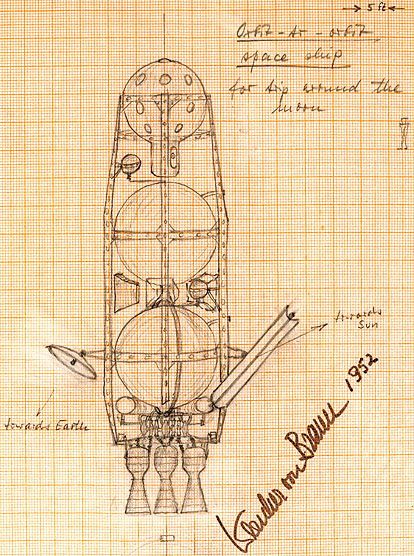
Drawing by Wernher von Braun of a moon ship concept (1952). It recently sold at auction for $132,000. 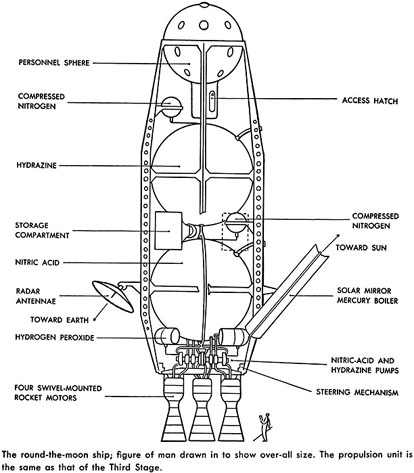
Diagram from Across the Space Frontier (1952), which is basically a compendium of all the Collier's articles.
Three-Stage Personnel Rocket
Another von Braun design for the Collier's series, this is the Ferry rocket. It is basically the Space Shuttle, mark negative-one. The poster version seems to have added wing extensions connecting the top canard wings with the midsection wings.
Relief Ship
The RM-1 rocket below is from Walt Disney's 1955 documentary Man in Space. I guess the poster painter thought the rocket needed to be spiced up so he added wings. The ship's nuclear reactor is mounted on a boom in the front, and a cone-shaped shadow shield protects the crew from radiation. There is also a docking port for a bottle suit underneath. The ship is 53 feet long and carries a crew of four. In the documentary the rocket does an orbital pass around the Moon.
Instrument Carrying Satellite
The Baby Space Station is another von Braun design for the Collier's series. It would allow testing of the space enviroments effects on structures and test animals. The animals would be studied for 60 days until they suffer the fate of Laika. Note the mercury boiler solar power unit at the top.
Three-Stage Rocket
This is one of the few pieces of space hardware that is actually from the real world. It's the Vanguard rocket. It was scheduled to boost the first ever satellite into orbit, before it got upstaged by the surprise launch of Sputnik 1. Six failures and one successful launch later it sent the Vanguard 2 satellite into orbit (see Weather Eye Satellite below).
The Vanguard had no fins since it was steered by gimbaled engines. I guess the poster artist thought that looked too undramatic and so added fins to the poster version.
Colony Sphere
![]() This is from an article by Frank Tinsley titled "How to get 25,000,000,000,000 miles away from it all" featured in the February 1953 issue of Mechanix Illustrated. Like many of Tinsley's concepts, it is grand in scope but some of the details are wildly impractical. For example: why not build the ship in orbit? Building it on the moon then launching the blasted thing seems counterproductive.
This is from an article by Frank Tinsley titled "How to get 25,000,000,000,000 miles away from it all" featured in the February 1953 issue of Mechanix Illustrated. Like many of Tinsley's concepts, it is grand in scope but some of the details are wildly impractical. For example: why not build the ship in orbit? Building it on the moon then launching the blasted thing seems counterproductive.

It's not easy. First build a space ship like this one, then, at the speed of light, it will take 30 generations to reach the nearst star.
FEW people realize the illimitable size of the cosmos in which they live. Even the nearest stars are separated from us by spaces so immense as to be almost incomprehensible to earthbound minds. Beyond lie black voids so vast that our whole solar system—sun, planets and satellite moons—is but a tiny pinpoint of light in a single galaxy of stars! The distances involved are so enormous that they are computed not in miles but in time. Astronomy’s unit of measurement is the light-year, the distance traveled by light in one year at a speed of 186,000 miles per second. Multiply this speed in a year (670,000,000 mph) by 24 hours and then by 365 days and you have the basic unit. It is a cute, little pocket ruler 5,880,000,000,000 miles in length!
There are eight stars within ten such light years of our sun. Of these stellar neighbors, Alpha Centauri and Proxima Centauri are the nearest. Faint pinpoints of light visible only by telescope, they are a modest 4.3 light-years away.
Starting with a space ship of present day rocket performance, a top speed of around 6.2 miles per second, Dr. L. R. Shepherd, Technical Director of the British Interplanetary Society, calculates that at that velocity it would take about 130,000 years to reach one of these stars. Alongside of this, a trip to the moon would be a mere ferryboat ride! This trip would entail the birth and death of some 30 generations en route (ummm, a generation is usually 25 years, so it is more like 5,200 generations, not 30).
To contain such a colony, its animals, plant life, etc., the space vehicle would have to be a modern Noah’s ark. The problems involved in maintaining artificial atmosphere and armoring the hull against cosmic dust particles make a spherical form almost obligatory. It would have to be enormous with a minimum diameter of ten miles. It would have to revolve around its directional axis to provide artificial gravity through centrifugal force, yet have fixed polar areas for astronomical observation, navigation, etc. It would have to take off from the moon where the gravitational pull is only one-sixth that of earth.
In the sphere, life would be conducted as nearly as possible as it is on earth. The whirling globe would contain towns and countryside, soil for crops, trees, lakes, roads and houses. There should be a sky above, an artificial reproduction of our atmosphere with a sun, moon, stars, day and night and even the change of seasons. In short, our space vehicle must be a small, self-contained world with all the features of our natural one. The only major difference would be that our colonists must inhabit the inside of their man-made planet instead of its exterior!
The design and construction of this monster globe is no short term proposition. It is a job for several generations——perhaps centuries!
The globe itself would be double-walled, with an armored outer skin and an inner pressure hull to hold the atmosphere. The space between would contain a tremendous area of hydroponic gardens, lit by artificial sun lamps and fed by chemical fertilizers for the manufacture of oxygen by natural plant processes. The outer skin would be pierced by rows of observation ports, radar domes and belts of solar heat plants.
Science-fiction? Maybe so, but it’s your vehicle if that’s Where you want to go.
- Outer skin armored against space dust
- Inner skin with interior earth crust
- Interskin chambers containing hydroponic gardens, power plants, etc.
- Hydrogen-fusion artificial sun
- Sun-supporting access spindle
- Artificial-atmosphere with clouds, weather, etc.
- Solar heat-gathering mirrors for power
- Control compartment with astral observatory above
- Radomes
- Cup-shaped base with inflatable rim and retracting legs for take-off and landing on spherical surfaces (landing a sphere ten miles wide? I don't think so.)
- Booster unit detaches after take-off
- Fuel cells
- Rocket battery
- Launching pit
Ship would have to be built and launched from moon where gravity is less (so why not build it in orbit where gravity is zero?). Launching site would be moon's crater eight miles wide, rimmed with roller bearings so sphere could revolve. Surface of crater would be lined with inflatable material like huge low-pressure tire to adjust for inequalities of ground and to provide cushion for take-off and landing——if you come back! (in 260,000 years...)
Sphere would start rotating by belt of jet engines. When interior gravity is built up by centrifugal force, crust of soil would be distributed on inner surface, landscapes created and houses constructed. Colonists would start living in their man-made world. Booster stalk would give it initial velocity. then rockets would take over. Ship would land on extensible tripod legs.
by Frank Tinsley, MECHANIX ILLUSTRATED (Feb 1953)

Third Stage Unit
The CR-1 rocket below is from Walt Disney's 1955 documentary Man in Space. It is the third stage of a three-step rocket, carrying cargo into low orbit. Note that both the poster and the Disney image has "shock diamonds" in the exhausts (the series of white puffs).
Flying Saucer
The Flying Saucers are Real by Donald Keyhoe (1950) was a hugely popular book in its time. Artwork by Frank Tinsley.
Space Station
![]() This is the classic "space wheel" style space station designed by Wernher von Braun for the Collier's Man will Conquer Space Soon series.
This is the classic "space wheel" style space station designed by Wernher von Braun for the Collier's Man will Conquer Space Soon series.
Research Ship
![]() This is the lunar expedition ship designed by Wernher von Braun for the Collier's Man will Conquer Space Soon series.
This is the lunar expedition ship designed by Wernher von Braun for the Collier's Man will Conquer Space Soon series.
Space Reconnaissance Ship
The "Space Scout" is a vehicle designed by G. Harry Stine in the early 1950's and appears in a book entitled The Answer to the Space Flight Challenge by Frank Tinsley (1958). It is meant to defend the United States against hostile space stations, which means nuking them with atomic missiles. You can find more details about it here. Note that the wings are supposed to make a "W" shape and have the control surfaces on the leading edge, not the trailing edge. The pods that the landing feet stick out of are also jet engines, and are suppose to have exhausts at the top of the wings, not closed off like the poster.
Space Recon Three Stage
This is the three stage booster rocket that lofts Stine's space scout into orbit. More details here.
Exploration Ship
This is a photon-drive rocket designed by Frank Tinsley. It appears in an article entitled "Light-Propelled Space Ship" by Frank Tinsley in the February 1954 issue of Mechanix illustrated. You can find more details here.
Weather Eye Satellite
This is one of the few pieces of space hardware that is actually from the real world. It's the Vanguard 2 satellite, which is launched into orbit by the Vanguard Rocket, on the poster as Three Stage Rocket. The Vanguard 1 satellite just sent tracking data, the Vanguard 2 had two optical scanners designed to measure cloud cover between the equator and 45° N latitude (hence "Weather Eye"). Unfortunately the scanners were not pointed in optimal directions so the data was disappointing. Vanguard 2 is still up there, it is not due to re-enter the atmosphere for another 300 years.
Space Suit
Passenger Unit
The XR-1 rocket below is from Walt Disney's 1955 documentary Man in Space. It is the third stage of a three-step rocket, carrying passengers into low orbit.
Observatory Satellite
![]() The Convair Observational Satellite was a space station designed by Krafft Ehricke, which was to be constructed from spent fuel tanks and other components cannibalized from used rockets. A nuclear reactor was located in the center, while the six-man crew was located far far away from the deadly radiation in the crew quarters on either end. The station was about 400 feet long, had an orbital height of 600 miles from the surface, and was intended to be used as a spy-in-the-sky platform to keep an watchful eye on those sneaky Soviets. Mr. Ehricke was trying to demonstrate the wide variety of stations and whatnot one could create out of spent fuel tanks.
The Convair Observational Satellite was a space station designed by Krafft Ehricke, which was to be constructed from spent fuel tanks and other components cannibalized from used rockets. A nuclear reactor was located in the center, while the six-man crew was located far far away from the deadly radiation in the crew quarters on either end. The station was about 400 feet long, had an orbital height of 600 miles from the surface, and was intended to be used as a spy-in-the-sky platform to keep an watchful eye on those sneaky Soviets. Mr. Ehricke was trying to demonstrate the wide variety of stations and whatnot one could create out of spent fuel tanks.
In the poster the center section has been replaced by a simple sphere, presumably because the poster artist was not being paid enough to paint the actual complicated tangle of tanks in the center.
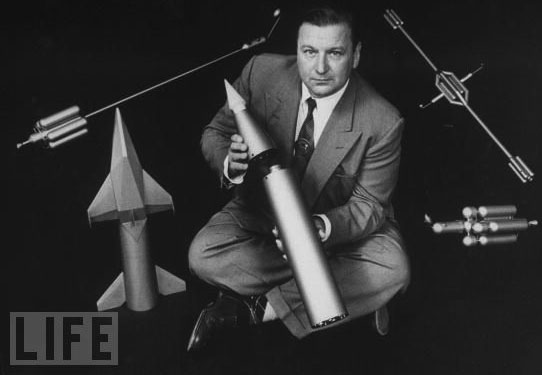
Krafft Ehricke with his designs, observational satellite is at upper right. From LIFE magazine, January 6, 1958. 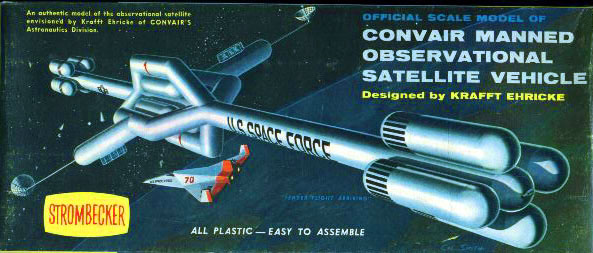
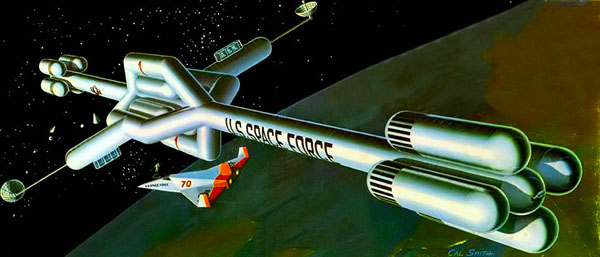
Exploration Ship 2
This is the Mars expedition ship from The Exploration of Mars by Willy Ley and Wernher von Braun.
MAN'S REACH INTO SPACE
![]() Man's Reach Into Space by Roy Gallant is a book that came out in 1959. You can see some of the great artwork by Lee Ames here.
Man's Reach Into Space by Roy Gallant is a book that came out in 1959. You can see some of the great artwork by Lee Ames here.
You can't have a book about space unless you include illustrations of space ships. This one had a two-page spread just full of them. You can see it above.
Sadly, the sources of all the images were not credited, and the descriptions were very terse and in some cases a bit misleading. Most of the ships appear to have been real designs created by the legendary Krafft Ehricke, who at the time was working for General Dynamics / Convair. He had been scooped up by Operation Paperclip. I briefly wrote about him and his brilliant idea to make a space station out of an Atlas rocket.
4 Stage Chemical
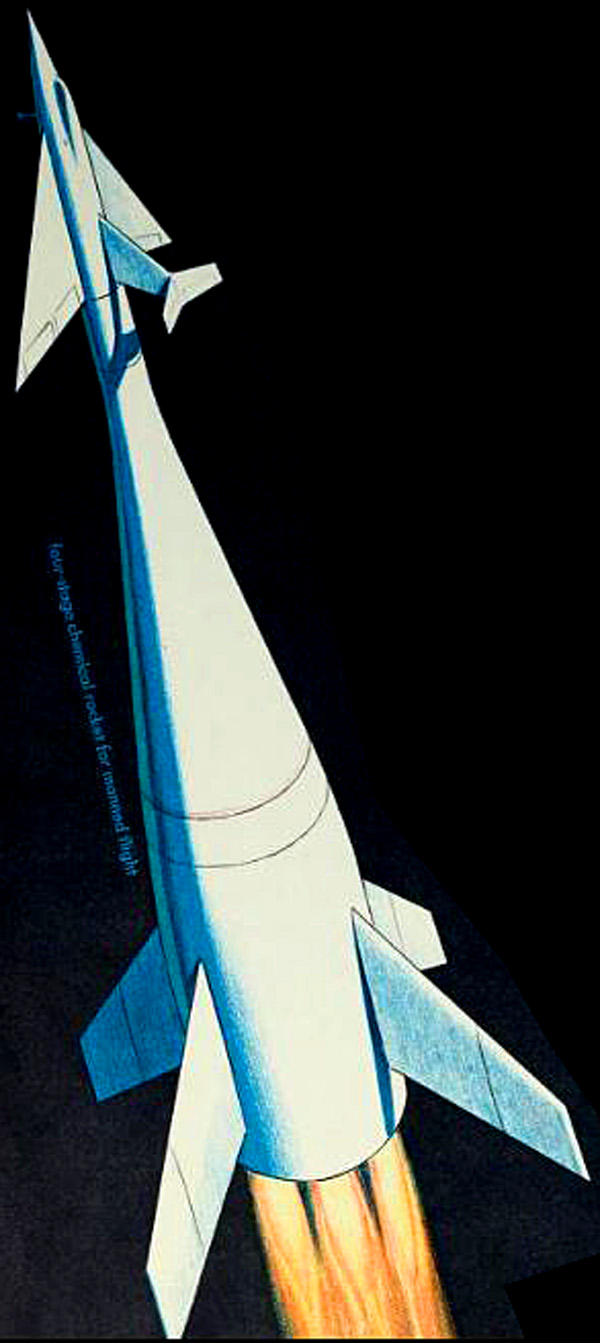
"Four stage chemical rocket for manned flight"
![]() In the 1950s Collier's Magazine gave the world "space fever" with a ground-breaking series of articles called Man Will Conquer Space Soon! (the series is reprinted for free, available here). The articles were written by top spaceflight experts: Willy Ley, Fred Lawrence Whipple, Dr. Joseph Kaplan, Dr. Heinz Haber, and Werner von Braun. Colliers had a circulation of about 4 million and they all were mesmerized by the stories of a space program.
In the 1950s Collier's Magazine gave the world "space fever" with a ground-breaking series of articles called Man Will Conquer Space Soon! (the series is reprinted for free, available here). The articles were written by top spaceflight experts: Willy Ley, Fred Lawrence Whipple, Dr. Joseph Kaplan, Dr. Heinz Haber, and Werner von Braun. Colliers had a circulation of about 4 million and they all were mesmerized by the stories of a space program.
Meanwhile, a certain Walter Elias Disney had a new TV program called "Disneyland". It had shows whose themes came from the major sections of Disneyland Park: Adventureland, Fantasyland, and Frontierland.
Oh, yes, don't forget the other section: Tomorrowland.
The Tomorrowland section of the theme park was devoted to show the visiters what life would be like in the future. So the TV show had to do the same. Disney looked at the Collier's series and had an idea.
Disney wanted to cash in on Space Fever. von Braun wanted to make crewed space exploration a reality. Neither were ever backward in making maximum use of new media for advancing their ideas. And the hot new media was TV. Both Disney and von Braun jumped at the chance.
von Braun became technical advisor for what became three entire episodes of Tomorrowland: Man in Space, Man and the Moon, and Mars and Beyond. Years later they were released on DVD, and all are currently available on Disney+
In the Collier's article, the key to an extensive human presence in space was a four-staged rocket called the Space Ferry. This was a reusable rocket that would transport into orbit the components for space stations and moon rockets. For the Tomorrowland episode Man in Space, von Braun updated the Space Ferry.
And that is where Lee Ames got the concept for the four stage chemical rocket.
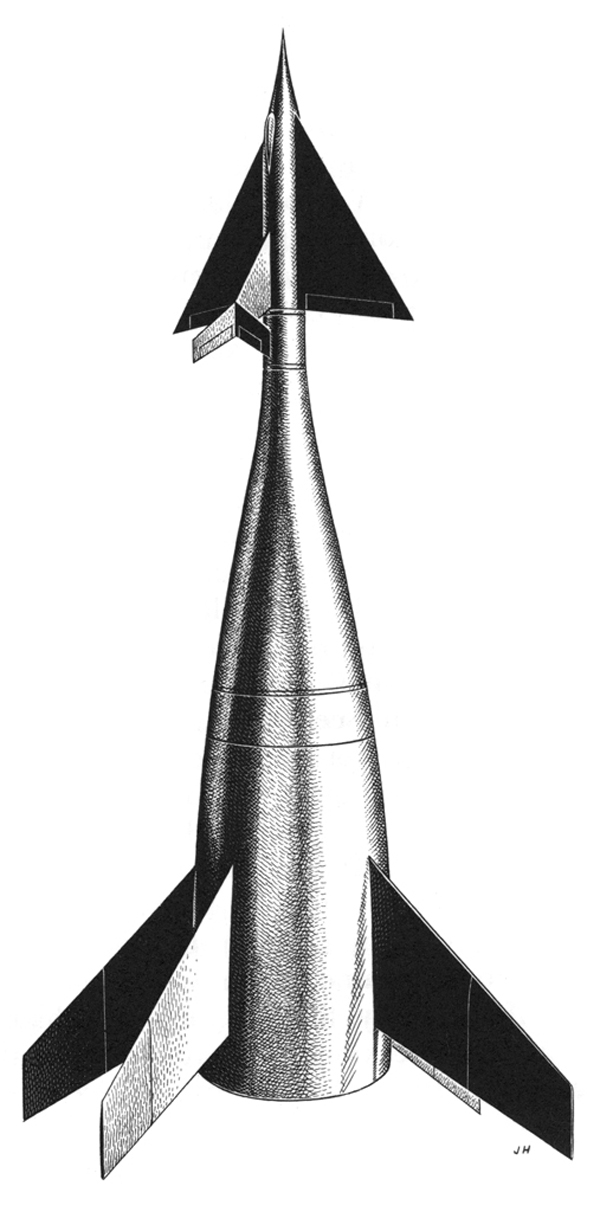
Disney/Von Braun space ferry design from the Man in Space series 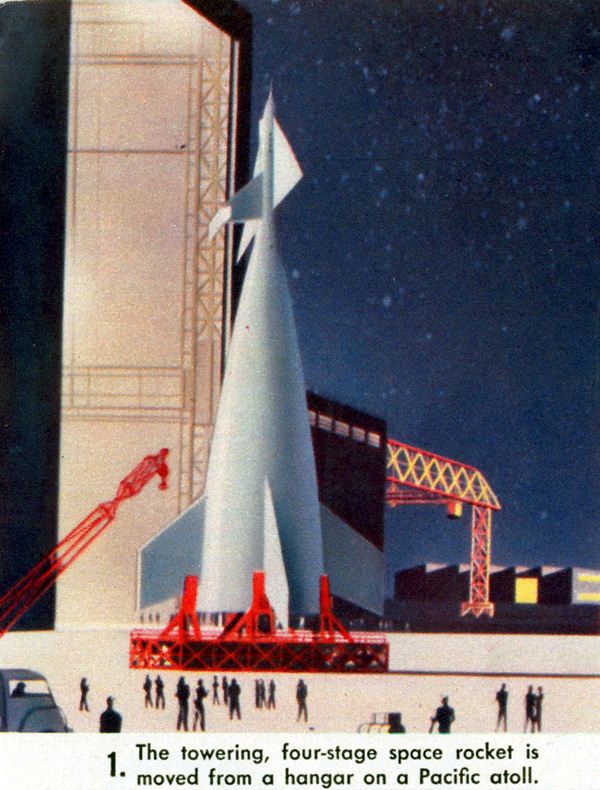
Disney/Von Braun space ferry design from the Man in Space series
Drag Brake
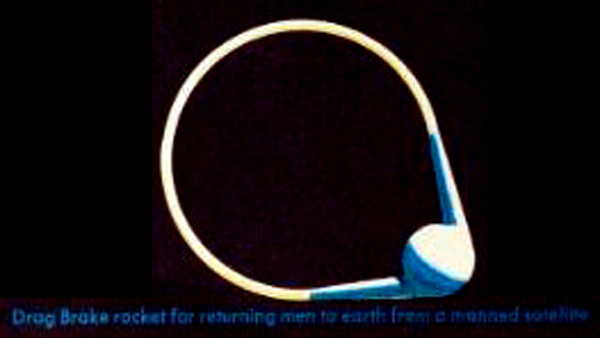
"Drag Brake rocket for returning {astronauts} to earth from a {crewed} satellite"
![]() Apparently this is based on a design by the Avco Research Laboratory for a reentry vehicle to return astronauts at a space station back to Terra.
Apparently this is based on a design by the Avco Research Laboratory for a reentry vehicle to return astronauts at a space station back to Terra.
So far the only information I can find is from an old issue of Life magazine. It says: "The Drag Brake, designed by Avco Research Laboratory, has a curious loop shape with a bulging cabin. The craft's motion through the air creates an electric current over its suface. Inside the loop a magnetic field is artificially generated. By a complicated electromagnetic effect, the electric current "collides" with the magnetic field. This slows the ship down, prevents excessive heating."
The nearest I can figure it is a form of magnetohydrodynamic aerobraking.
3 Stage Chemical
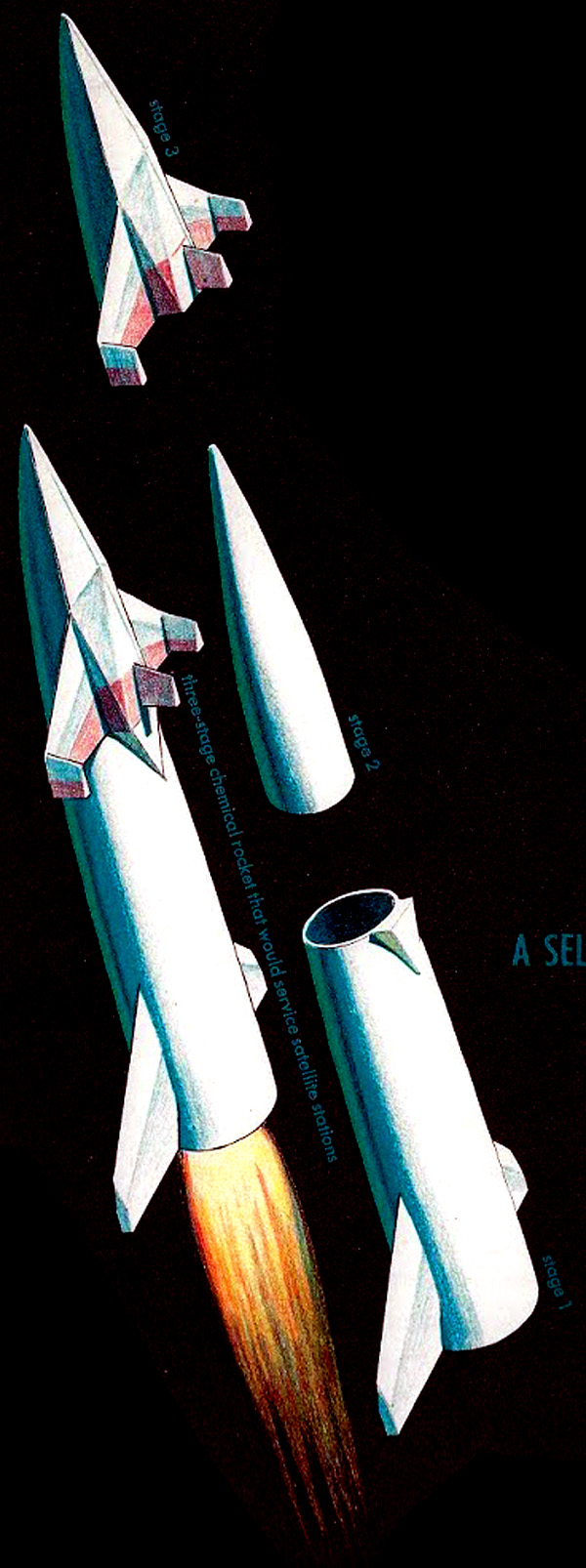
"Three-stage chemical rocket that would service satellite stations"
![]() This is based on the Convair Shuttle, designed by Krafft Ehricke.
It does not have much cargo capacity. It was apparently intended to deliver repair crews to expensive satellites for fixing malfunctions and maintenance.
This is based on the Convair Shuttle, designed by Krafft Ehricke.
It does not have much cargo capacity. It was apparently intended to deliver repair crews to expensive satellites for fixing malfunctions and maintenance.
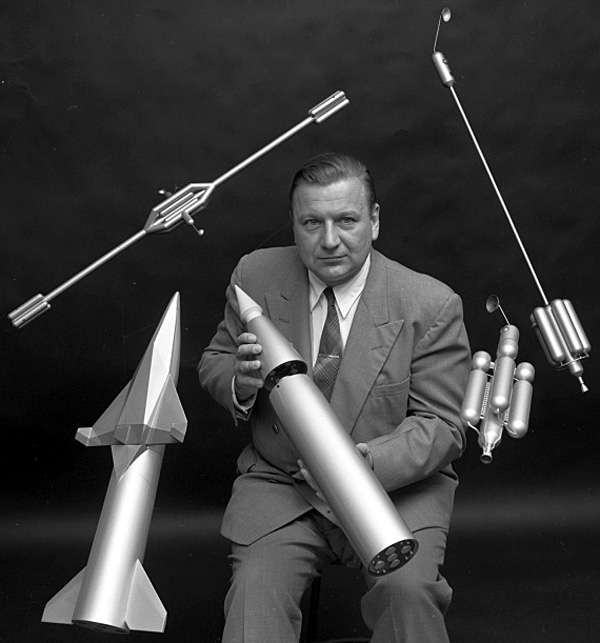
Convair shuttle at lower left 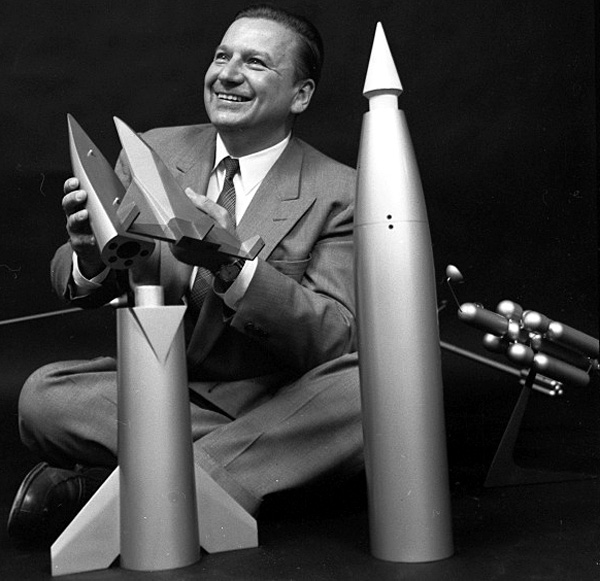
Convair shuttle at lower left
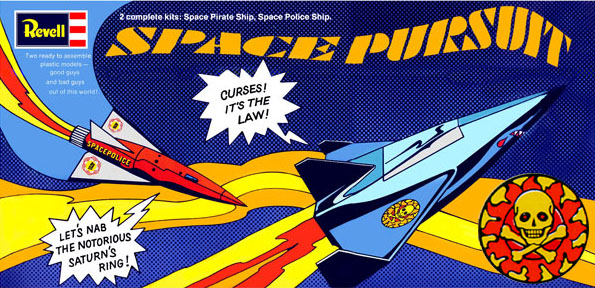
Revell plastic model kit Space Pursuit (1969). A repackaging of the Moon Ship and the Convair Space Shuttle.

artwork by Ron Miller
Mars Snooper

"Mars Snooper, a manned nuclear-fueled reconnaissance craft"
![]() This was "inspired" by the Mars Snooper invented by the amazing Frank Tinsley. You can see some of Tinsley's other work here.
This was "inspired" by the Mars Snooper invented by the amazing Frank Tinsley. You can see some of Tinsley's other work here.
The two-ended engine arrangement of the Mars Snooper appears to be from an earlier design, the Space Scout designed by G. Harry Stine. In space, the petals on the base open to expose the nuclear rocket and the ship moves pointy end first. When landing on Earth, the petals close, and the ship moves blunt end first. The nuclear reactor gulps atmosphere for propellant, heats it, and shoots it out the ramjet. The blunt end is the heat shield, with channels for coolant.

This nuclear-fueled reconnaissance craft is preparing to land on Mars’ outermost satellite, Deimos — 12,500 miles away from the "red planet“ (center) and 35 million miles away from the Earth. Deimos‘ gravitational pull is so slight that a featherlight landing could be made, and a take-off could be accomplished with little more than a shove of the pilot’s foot! (At Deimos’ orbital speed, such a push would start the ship back to Earth at 3000 miles per hour.)
Our spaceship is designed to fly in two direction—nose first as a space rocket and tail-first as a ramjet airpiane. Propulsion for both is provided by a singie atomic heat source. reacting with hydrogen for rocket thrust, and with atmosphere to power the ramjets.
Travel to Mars, braking for landing. take-off and re-entry are accomplished by rocket-thrust. As the ship approaches the Earth's atmosphere, it assumes a tail-first attitude. The “petal doors" enclose the rocket nozzle, and the ship is transformed into a high speed, ramjet airplane with M-shaped wings. Control fins are located in the nose of the craft, near the crew's quarters.

Manned Satellite
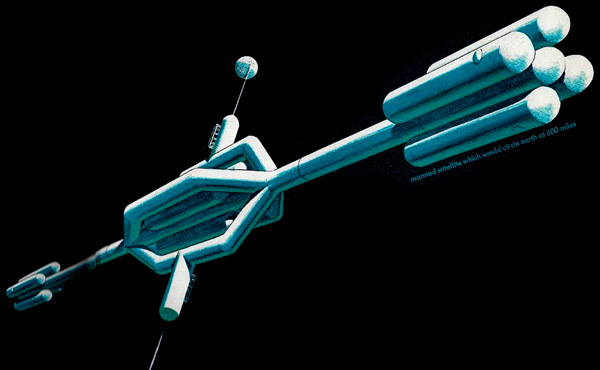
"{Crewed} satellite which would circle earth at 600 miles"
![]() This is based on the Convair Observational Satellite was a space station designed by Krafft Ehricke, which was to be constructed from spent fuel tanks and other components cannibalized from used rockets.
This is based on the Convair Observational Satellite was a space station designed by Krafft Ehricke, which was to be constructed from spent fuel tanks and other components cannibalized from used rockets.
If it looks familiar, that's because this was also featured in the Space Age poster.

Krafft Ehricke with his designs, observational satellite is at upper right. From LIFE magazine, January 6, 1958.
Mars-Venus Nuclear
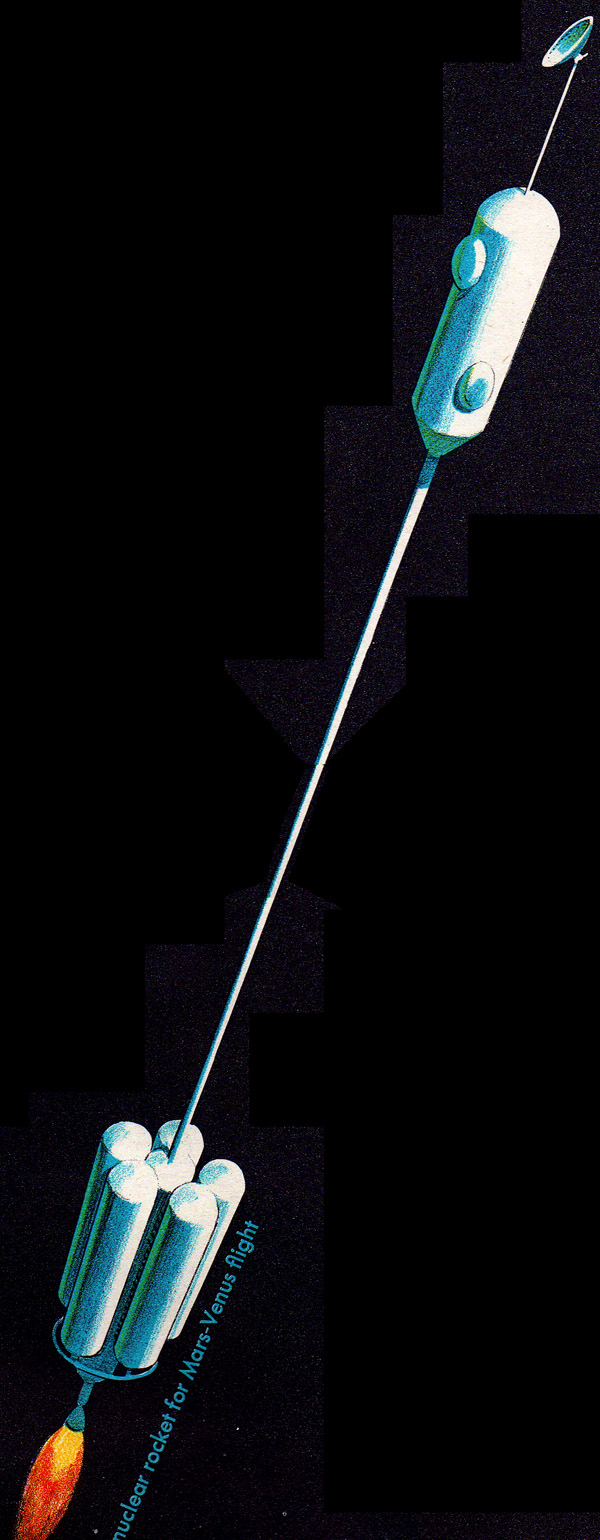
"Nuclear rocket for Mars-Venus flight"
![]() This is based on Krafft Ehricke's nuclear spacecraft.
This is based on Krafft Ehricke's nuclear spacecraft.
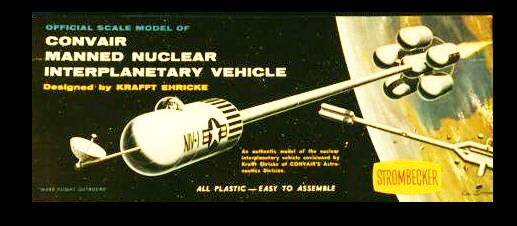
Strombecker model #D-38 designed by Krafft Ehricke, 1957
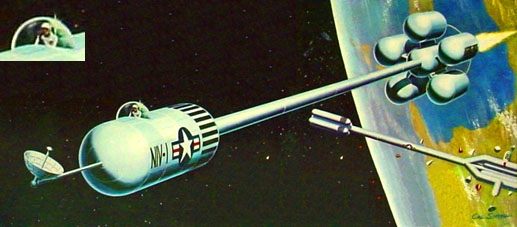
Strombecker model #D-38 designed by Krafft Ehricke, 1957
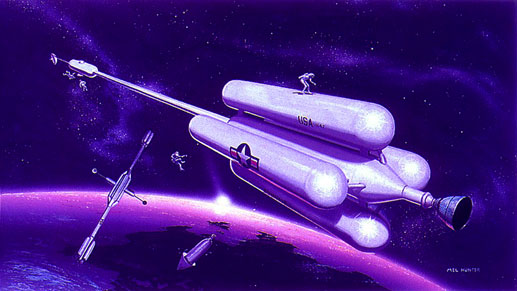
Artwork by Mel Hunter

Krafft Ehricke with his designs, nuclear spacecraft is at upper left. From LIFE magazine, January 6, 1958.
Lunar Satellite Vehicle
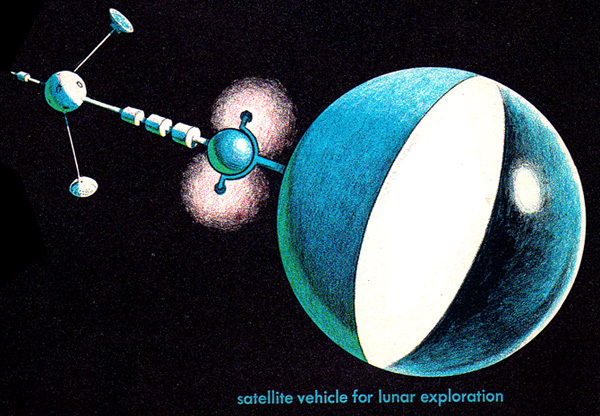
"Satellite vehicle for lunar exploration"
![]() This is based on Krafft Ehricke's solar moth spacecraft.
This is based on Krafft Ehricke's solar moth spacecraft.

“A sun-powered space ship of tomorrow – the crew rides in the gondola with radar antennas. Designed by Krafft A. Ehricke of [the] Convair division of General Dynamics Corp.”
Mike Acs: Two engines facing away from the viewer, fed by two fuel lines, coming from the large spherical solar collector/concentrator, and partially girdling the central sphere — appear to be firing. Beautiful work by Convair's prolific and talented artist/illustrator — John Sentovic.
Wing Ion Rocket
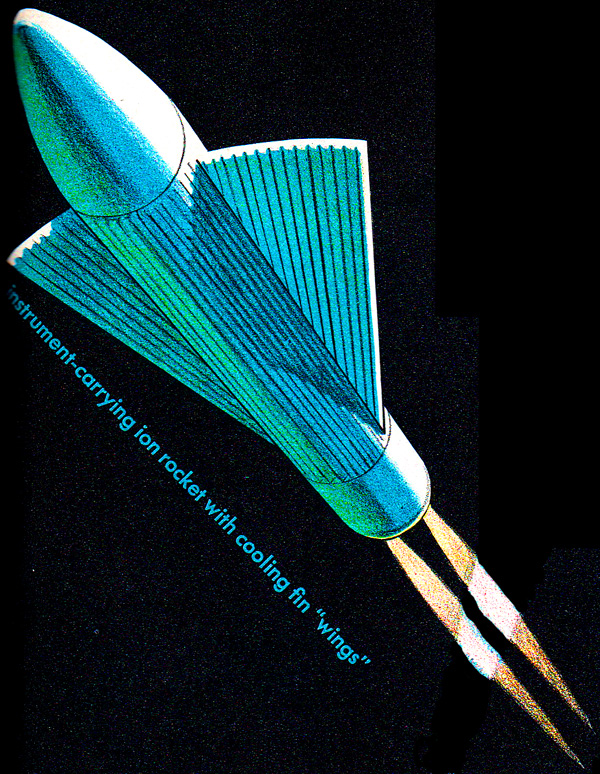
"Instrument-carrying ion rocket with cooling fin 'wings'"
![]() Inspired by a design by Rocketdyne. "Instrument-carrying" is their way of saying "uncrewed." The design shown has acceleration measured in snail-power, so it will take decades to get anywhere.
Inspired by a design by Rocketdyne. "Instrument-carrying" is their way of saying "uncrewed." The design shown has acceleration measured in snail-power, so it will take decades to get anywhere.

Ion-powered vehicle for flight in outer space. About the size of present missiles, this vehicle would be propelled through vacuum of space at thousands of miles per hour by only a few pound of thrust. Discharge of ionized particles — rather than gas as in conventional rockets — would provide propulsive force. Nuclear reactor would generate power for ionization. Wing-shaped attachments to vehicle are radiators to reject excess heat. Direction of flight would be controlled by swiveling rockets.
Ion Rocket
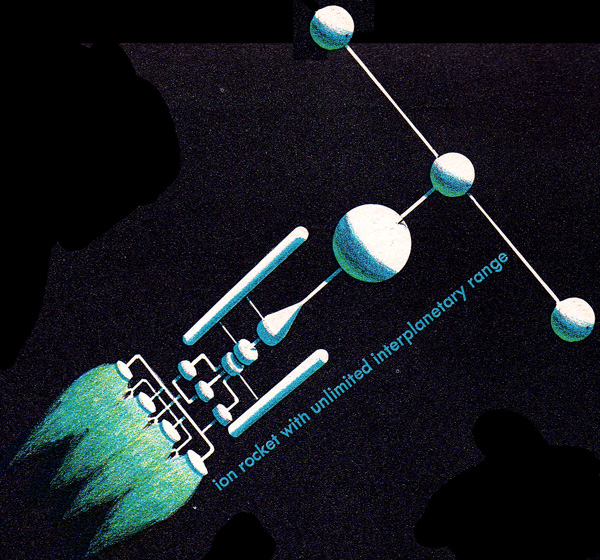
"Ion rocket with unlimited interplanetary range"
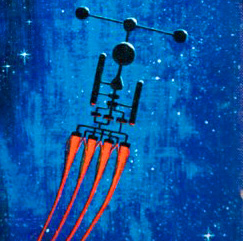
The three spheres on the top look suspiciously like two habitat modules on an artificial gravity centrifuge.
Artwork by Lee Ames for Man's Reach Into Space by Roy Gallant (1959)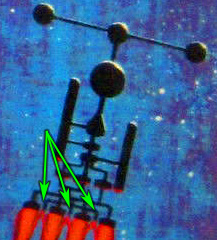
Note the beam neutralizers between the pad-like ion engines.
Artwork by Lee Ames for Man's Reach Into Space by Roy Gallant (1959)
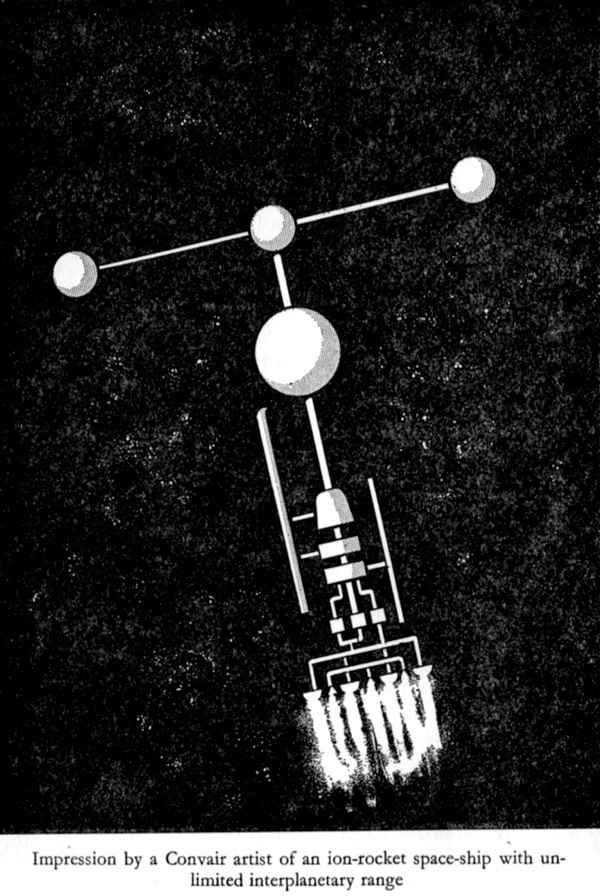
Impression by a Convair artist of an ion-rocket space-ship.
